#IT'S A NATIVE SPECIES BUT SO ARE A LOT OF THE BIRDS ON EXHIBIT
Text
hey i'm at the zoo outside the new bird house and this heron is just fucking standing on the rail next to some of the exhibits?

is this a fugitive or a random fucking wild animal
#IT'S A NATIVE SPECIES BUT SO ARE A LOT OF THE BIRDS ON EXHIBIT#it seems used to people coming at least relatively close but it's not banded and we're not terribly near like a proper body of water#so like. what the fuck#sasha speaks
16 notes
·
View notes
Text
Merry belated Christmas everyone!!! I’ve been wanting to make a post for a while now but things have been pretty hectic between coming back from my trip to Florida and helping my family with last minute preparations for Christmas. After that my brain needed a few days to just be goop but I’m back now and want to talk about something pretty cool! So while I was in Florida me and my bf went to go visit this wetlands called Green Cay where you can walk around a board walk and see some pretty cool birds and reptiles. The day we went was pretty cold and cloudy (it was like that for most of the time I was there) so that meant there weren’t many reptiles out but it also meant there weren’t many people there either so we got to see a lot of really cool birds!
As soon as we pulled up to the parking lot we were seeing birds such as blue jays, northern mocking birds, common grackles (of course), a red-bellied woodpecker, mourning doves, and a bunch of squirrels. I know none of those species are rare so it makes sense that I would see them but I think it’s so cool to see species that I’m used to like blue jays, squirrels, and woodpeckers hanging out in palm trees.

(Red-Bellied Woodpecker)
Next, we went into the visitor center where they had a few exhibits with animals. The first was a display about native frogs Vs invasive frogs that had Cuban tree frogs and cane toads for the invasive species and green tree frogs, pig frogs, and southern toads for the natives. Sadly, I could only find the Cuban tree frog, cane toad, and pig frog since the glass was super foggy and the frogs like to hide anyways. They also had an American kestrel named Kilee and an Eastern screech owl named Oliver in little flight cages. Both birds were born in the wild but now have injuries that prevent them from flying so they have to live the rest of their lives at the center. The sign said Oliver had been hit by a car and for Kilee it just said she had problems with her wing feathers so idk what happened to her. There was also two tanks one that had turtles (peninsula cooters, Florida softshell, and Florida red-bellied) and a second tank that had some baby American Alligators.
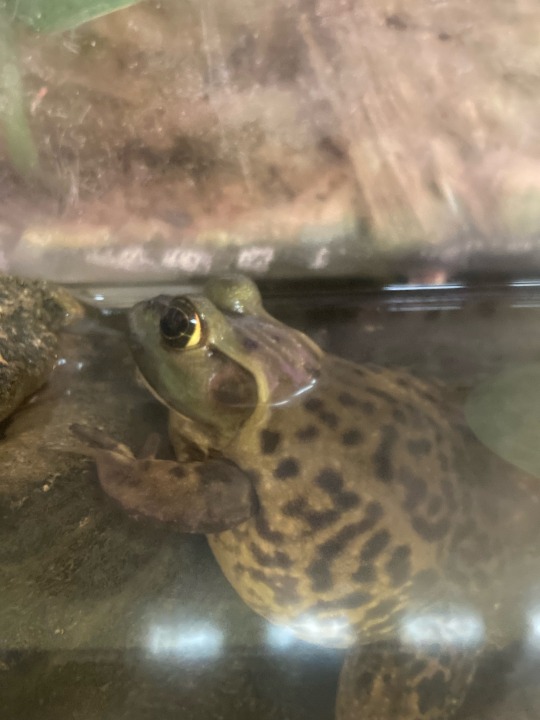
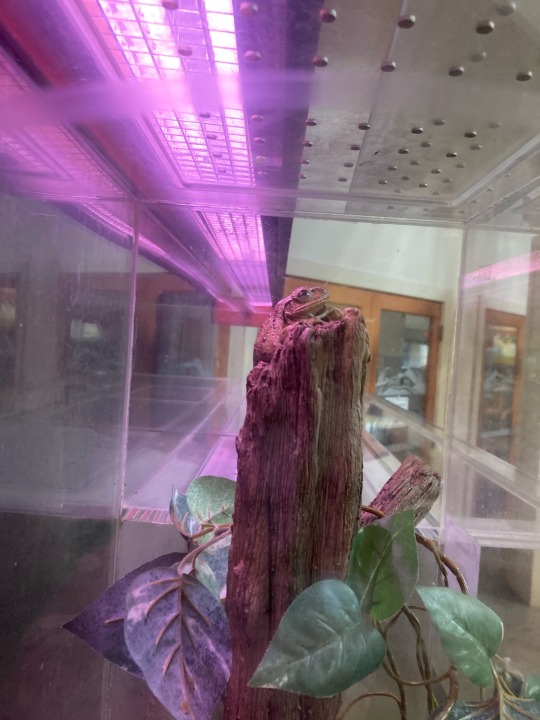


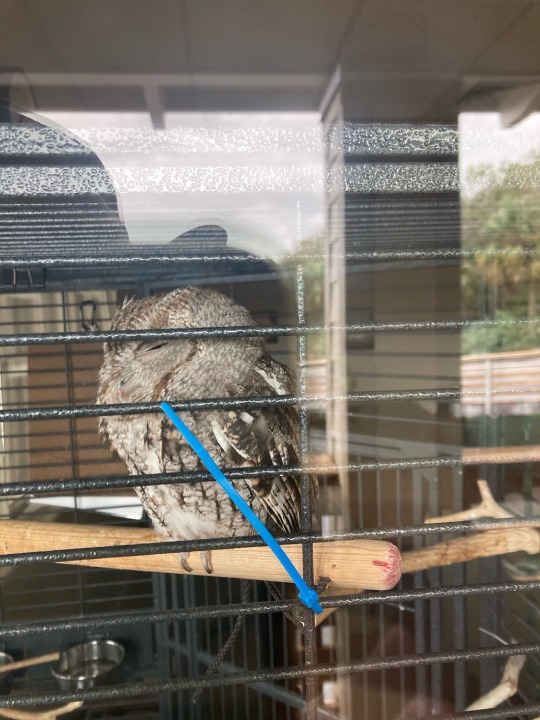

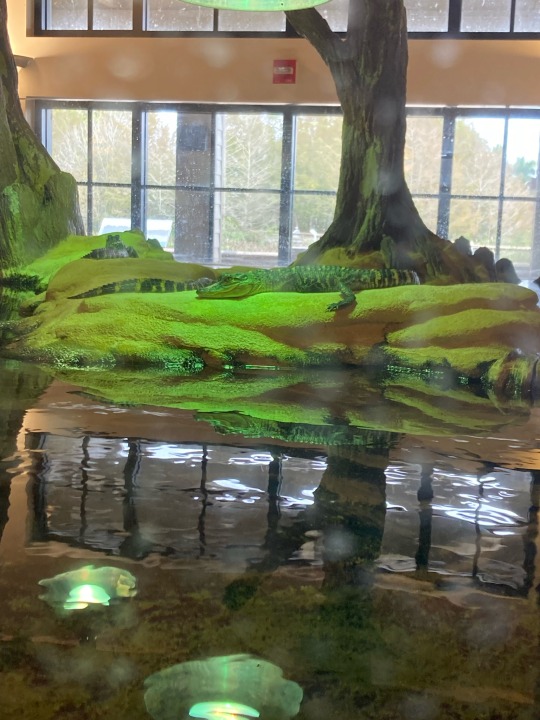
(Pig frog, Cuban tree frog, Kilee the American kestrel, Oliver the Eastern screech owl, peninsula cooter, and American alligator babies)
In the actual park we saw lots of cool species since there weren’t many people out. Like I said no alligators though since it was pretty cold out but we did see plenty of iguanas, a massive Florida Softshell in the water, and a basilisk lizard sitting in a tree!
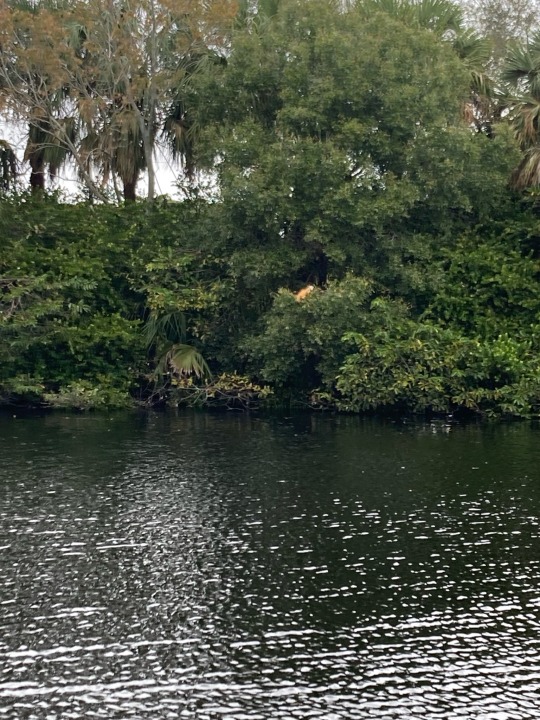
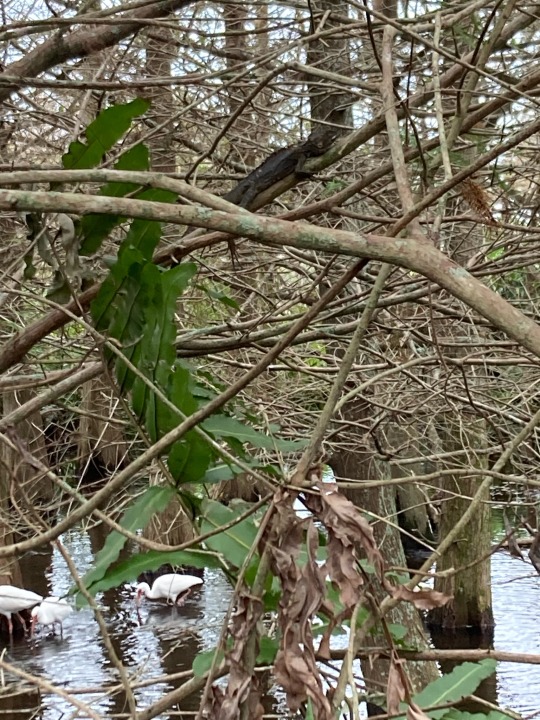
(Large male green iguana and either a brown basilisk or a green basilisk who isn’t showing off his coloration we couldn’t tell)
That’s all the pics I can add to this post so I’m gonna make a part 2 with all the birds we saw.
#animals#florida wildlife#florida softshell turtle#florida#green cay#wetlands#north american wildlife#wildlife#animal lover#tree frog#kestrel#screech owl#american alligator#turtles
5 notes
·
View notes
Text
some headcanons on eden-6 fauna and flora bc im deranged 👍
there's a lot, and i mean a lot of termites, many of which feed on wood. to combat this, certain trees developed toxins which course through their sap, which are specifically tailored to fuck up the termites' digestive systems. humans don't give a shit about the toxins, but the areosolized forms of a few of them are actually very pleasant smells (the wood is reserved for high-end weapons or fancy furniture, usually), plus the bugs don't eat their fancy oldtimey wooden stuff
eden-6 just has a lot of big bugs in general, relatively speaking. nothing like spiderants or varkids, but many isopods, dragonflies, mosquitoes, etc. the swamp muck is chock full of nymphs and larvae a sizeable portion of the year
oh and gastropods. most have no shells (aka, they're slugs), as even the "dry" season is very humid
orchids. lots and lots of orchids. epiphytes in general but there's a shitton of orchids. they take advantage of the moist air to focus on growing large leaves, trying to capture as much light during dry season as they can
glowing fungus. idk why i just think this planet deserves it. some form lichens, which are probably one of the gnarliest looking lichens in the whole borderlands
there's also a lot of carnivorous flora (majority of carnivorous flora irl is native to swamp environments, which are poor in nitrogen), and they grow to pretty big sizes
the dominant taxon is definitely reptiles (saurians), coming in many many varieties. you probably know of the trex-esque grogs and such, but there's other ones! here's some saurian facts because i love them:
there are no "true" birds on eden-6, but there's quite a bit of archaeopteryx-esque small saurians that fill a similar niche
many of the smaller, more "primitive" saurian species exhibit amphibian-like traits, such as webbed feet, the ability to croak and frog-like eyes
saurians are primarily nesting creatures, caring for their young and viciously defending their eggs (and they have a reason to do so, since jabbers love to steal them). despite this, a few still evolved into dedicated ovivores. based
the "horns" on larger species are actually adapted teeth, growing elsewhere on the body, used as intimidation factor, weapons and defense against being eaten
speaking of teeth, saurian teeth do not have pain receptors and are replaced quickly, sort of like shark teeth. you can file them down to not stab you and it won't hurt them one bit
#my post#borderlands#text post#headcanons#ask to tag#insects#bugs#animal death#speculative biology#sorta?
15 notes
·
View notes
Note
Wait wait Grian is an African Grey in ruft au?? I must have forgot or didn’t realize because I would have been going insane about this sooner! African greys mean so much to me, my grandparents had one when I was growing up and I love them very much. Grian being one makes me so so very happy <3
Yeee!!!! The only thing. The ONLY thing I had planned from the start was that he was based on an african grey
So hilariously. I am. Terrified of birds. Genuinely so scared of them. [I am also terrified of dinosaurs. I wonder if these things are connected somehow.] And I have, coincidentally, a lot of friends who own or otherwise work with birds. Including a man here who helps take care of my local zoo's bird exhibit hall, of which one area consists of a room about the size of an acre [okay. that might be an exaggeration but it is at LEAST a half acre] full of trees native to the amazon and unsurprisingly, a lot of tropical birds. Yes I know the African Grey is not a bird from south america but I'm going somewhere with this.
So this room - I never wanted to go into it as a kid, I would burst into tears, because like. The birds are just free roaming. They're allowed to go anywhere in the room. They do feeding shows and many of the birds are used to humans so they'll get quite close to you regardless. There is a macaw in this room who is WELL acquainted with humans and likes to land on people's shoulders. He scared the SHIT out of me as a kid bc I mean - macaws are huge birds. And here one was, just sitting on my dad's shoulder.
So years later, I'm in college and well. As I'm sure people have noticed on here, I like to make friends and generally just like talking to people. So I make friends with bird guy and he gets me an after-hours tour of the bird hall - it's just me, him, and a few coworkers, one of whom is the primary caretaker of this giant bird room. And they have taken it upon themselves to help me get over my fear of birds.
It's a feeding time for the birdies so I am tasked with holding some birdseed out - the birds that eat the birdseed are generally the smaller species in the room and I have one or two takers, while most of the birds sort of peck at the ground - and then this Macaw shows up. And he lands on my arms and I get scared and drop all the seed in my hands. But he does not lead. In fact he scoots closer to me, and I nearly burst into tears. Now - they dont try to train the birds or anything to mimic human speech, but parrots who're comfortable w people, im told, 'do as they will', and so this parrot goes 'Sad? Sad?" whilest like, tilting his little head in my face. And I mean that is just simply so startling that I stopped crying and was like "Uhhhh. Yeah. I guess."
This is not a disney story, he didn't like magically know what to do with that or anything and one of his keepers took him from me because I was, you know, clearly in distress. But I think that experience is sort of what got me interested in birds ANYWAY and now I've got a lot of friends with birds and watch a lot of bird videos - and ONE of these friends has an african grey parrot that is genuinely one of the nicest animals, of any species, I have ever met. So I warmed up to her and she is like a beloved niece to me. I love going to like, a pet store and buying her a new toy for her room [Bc. she has. An entire room in my friend's apartment god bless.]
Anyway this story got out of hand but yeah, Grian's an african grey because I think I've got a bit of a bond with parrots in general now and. One little african grey has won my heart. love her.
[For those curious, the Zoo's Macaw is named 'Michael' bc he DELIGHTS in saying his name when people say the word 'macaw'. 'Michael Macaw Michael Macaw!' and my friend's parrot is named Seedie - Like Sadie but. Seed.]
4 notes
·
View notes
Text
Six Cool Things To Do In Phoenix Arizona
Phoenix, Arizona is one of the most well-known cities in America. It's also home to some of the best things to do in all of America. Whether you're a traveler looking for your next vacation destination or a local who wants to get out of town, Phoenix has you covered! Here are some cool places that will make your trip more fun:

Visit the Desert Botanical Garden.
The Desert Botanical Garden is an amazing place to visit in Phoenix. It's a botanical garden, so you can expect to see lots of plants and trees (but not too many flowers). You'll also get to learn about desert ecology outside the beautiful desert scenery.

Location: 1201 N Galvin Parkway, Phoenix AZ 85008
What to Expect: The garden was designed by Fredrick Law Olmsted Jr., who also designed Central Park in NYC and the Biltmore Estate in Asheville NC. It's got over 10 miles worth of trails for you to explore! There are different sections including Sonoran Desert Gardens, Native Plant Display Areas with Southwestern plants from Arizona, California & New Mexico; Native Flora Special Exhibits; Water Sustainability Showcase featuring native tree species that use less water than non-native trees; Best Dressed Lawn Competition showcasing local lawns with native landscaping throughout AZ (with prizes given out every year!), plus there’s even an animal section where you can see animals like lizards or birds if they happen to come by on any given day.
Take a guided ghost tour through Old Town Scottsdale.
Old Town Scottsdale is a historic district that's got it all: eclectic dining, tons of shopping and live music, art galleries, and even haunted sites. If you want to get in on the spooky fun without having to venture far from your hotel room in Paradise Valley or Tempe, book one of these ghost tours through Old Town Scottsdale.

You'll be able to see some of the historic buildings in the area like The Hotel San Carlos and Hotel Valley Ho (formerly The Fairmont Princess), learn about their history as well as stories about paranormal activity that have occurred there. Tours are offered year round but are especially popular during Halloween season so make sure you book early if you'd like to take advantage of this spooky opportunity. It's also perfect for families with kids who enjoy learning about history and getting into character!
Catch a Pro Baseball Game at Chase Field.
Chase Field is home to the Arizona Diamondbacks, one of Major League Baseball's 30 teams. And while you may not be able to catch a game with them, you can still have fun at Chase Field.
The stadium was built in 2000 and is located in downtown Phoenix. The stadium has 42,000 seats and features an eight-story tall retractable roof that allows for open air baseball during warm days or closed roof for cooler temperatures or rain. You'll also find several restaurants inside including Dierks Bentley’s Whiskey Row, Dirty Little Roddy's BBQ & Rock'n Roll Kitchen (Dirty Little Roddy is a mascot for the team), and two new sections called "The A" and The Porch featuring burgers from 5th Street Burger Co., chicken wings from Wingstop and craft beer from Four Peaks Brewing Company
Go to the Phoenix Art Museum.
The Phoenix Art Museum is a great place to go to learn about art. The museum has a collection of over 17,000 pieces of art and many exhibits that change every few months. The museum is open every day except for Thanksgiving and Christmas.

You can also check out the Phoenix Art Museum’s online database where you can research artists or view their works by genre. You can even see if there are any upcoming events at other museums in Arizona!
Take the kids to Castles N' Coasters for fun and games.
It's not just a theme park, it's an amusement park, too! Kids (and adults) can ride roller coasters, water rides and other rides for kids. Or they can try their hand at one of the many games or play in the arcade.
Stop by the Musical Instrument Museum for a look at an extensive collection of instruments from around the world.
The Musical Instrument Museum is a great place to learn about the history of music, and see some cool instruments. It's also a wonderful place to take your kids, or just explore on your own. The museum has an impressive collection of instruments from around the world, and is located in Tempe, Arizona.
If you're looking for something fun to do in Phoenix with family or friends (or both!), this museum has something for everyone.
There are many things to do in Phoenix Arizona that can be fun for all ages.
Phoenix is a great place to visit, especially if you are looking for some fun things to do. The city has a lot of activities that can be enjoyed by everyone. If you are visiting Phoenix Arizona and looking for things to do with your family or friends, then this article will give you some great ideas about what the city has available for your enjoyment!
The first thing that comes to mind when thinking about things to do in Phoenix Arizona is visiting the Grand Canyon. This is one of the most famous landmarks in all of America and it's also very close by so it makes sense that people would want to go see it while they're there! However, there are many other places as well.
If you’re looking for a place to visit on your next vacation, Phoenix Arizona is a great choice. With everything from museums and gardens to sports games and theme parks, there are plenty of things to do in Phoenix Arizona for everyone in the family. From fun activities that will keep kids busy all day long (like Castles N' Coasters) to places where you can enjoy some peace and quiet (like the Musical Instrument Museum), there really is something for everyone here!
Are you looking for some tree removal or stump grinding services in Phoenix? You’ve come to the right place. USA Tree Removal and Stump Grinding is your number one choice. We are dedicated to getting rid of all the unwanted trees in your yard, on a time schedule that works best for you. Check out our website where we offer competitive pricing and excellent service.

USA Tree Removal and Stump Grinding
2513 N 29th St, Phoenix, AZ 85008, United States
623–469–7674
https://phoenixtreecare.org/
https://www.google.com/maps?cid=12337577927580498513
1 note
·
View note
Text
Let’s take a moment to talk Shit.
You can tell a lot about the health of a pet by its poop.
Changes in its color or consistency are among the first warning signs that a pet may not be feeling well.
In birds, you will usually see changes in poop long before the changes in behavior that indicate illness, like irritability or lethargy.
When most people think of pigeon poop, This is what usually comes to mind:
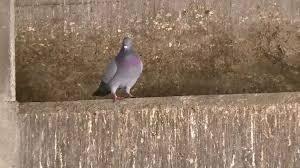
Nasty white streaks
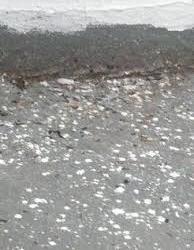
Or splatters

Or gross colored splats

Any place feral pigeons frequent.
But this is what poop from a healthy, well fed pigeon looks like:
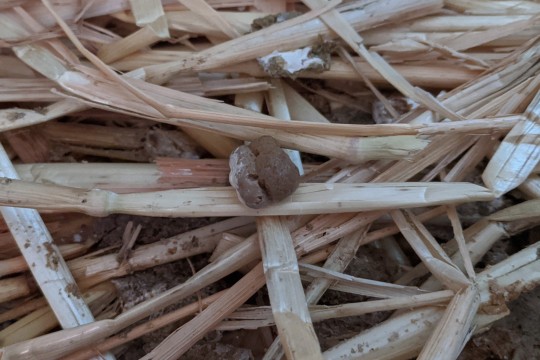
A small, compact ball of the indigestible fiber left over from the hulls of the seeds they eat whole, with a tiny white cap of urate.
You can see the consistency from the others underneath it, where nesting straw has been mashed into them as Pippin has come and gone and arranged, and rearranged individual blades.
A reliably well fed and hydrated pigeon will usually leave stools that keep their round shape on impact with a texture slightly softer than well worked playdoh.
Pigeon poop can be sloppy after a big drink of water following a 6-12 hour period of having gone with out.
The bowel movement after their first drink of water in the morning, for example, may make a sloppy mess, but in a healthy, well fed pigeon, the solid part will still be brown, and there will be more water than the white urate.
Look at this third picture again:

That wet mess of solids on mostly urate, with a mucus-y shine and slimy texture, is indicative of a heavy gut load of intestinal parasites.
Not just most ferals, but most racing, performing, and exhibition pigeons (since there are often housed out doors) are infested with the nematode Capillaria, the round worm Strongyloides, or the protozoan Coccidia.
While usually sub-clinical, an active infection of Salmonella will turn the poop a distinctive sulfur yellow to lime green.
But poop is only pure white,

Like those streaks and splatters most people associate with feral pigeons, when the birds have not had access to solid food in 12 hours or more.
Nearly all feral pigeons perpetually teeter on the brink of starvation, and it shows in their poop.
They are strict granivores, meaning that they can only digest seeds: the embryonic tissue of plants.
With cities being so carefully landscaped, often with the only plant life available being in the form of flower beds and trees, with grasses only in public parks and mowed too short to bloom and seed, the food they can actually digest is mighty hard for the average feral pigeon to find.
Barn ferals tend to be much more healthy for access to seed and animal feed.
But spilled garbage and the hand outs of the people that like them enough to feed them are literally all the food city ferals have access to.
Most of that is bread.
And while bread is made from grain, milling that grain and baking it into bread breaks it down, making it easier for a HUMAN to digest, but HARDER for a pigeon.
They like the taste of it, and eating some as an occasional treat won’t do a pet bird any harm, but that’s the VAST bulk of the food feral pigeons have access to.
It would be like a humans having to wander for miles every day to find food, but only being able to find potato chips, snack cakes, and the occasional slim jim.
That human would not have a long, or healthy life.
Now imagine that person ALSO had two different kinds of lice, mosquitos, and a parasitic fly sucking their blood from the outside, a painful cheesy growth in their throat that could block off their trachea or esophagus if it goes untreated long enough, two species of worms eating the nutrients they manage to find before their intestinal lining gets the chance to absorb it, and a protozoan eating their intestinal lining, with no hope of getting any of those things treated.
And you have a pretty accurate representation of what it’s like to be a feral pigeon living “free”.
I am all for wild animals living free in the environment for which they were adapted.
But pigeons are not wild life, and they were not adapted to cities.
ESPECIALLY not on the continent of North America.
The pigeons that were brought here as military messengers, meat, and entertainment had been domesticated for thousands of years already.
When homers were no longer faster and more reliable messengers than phone lines or radio waves, they were no longer profitable to keep, pigeons were released.
This was common practice in the places they came from.
But in Europe, Africa, Turkey, and Saudi Arabia, where Rock Doves are native, there WAS natural habitat for the exclusively cliff nesting birds to relocate to, as well as open lofts that would welcome the boon of free livestock.
But there is nothing like their actual habitat: A high cliff near the sea, between desert and grass land, in north America.
So, as lofts shut down and were (as they still are to this day by racers) habitually destroyed to discourage the birds no one would buy from returning, there was nowhere for the unwanted birds to go EXCEPT the tall, concrete buildings, and the metal structure under bridges and billboards.
The problem of feral pigeon mess, from the structural damage caused by the pure uric acid they excrete on an empty stomach to their potential as vectors for zoonotic disease is one of our own making.
That’s why I don’t re-abandon feral pigeons that come into rehab by releasing them.
I get them medical care. Heal their wounds, treat their infections, clean out their parasites...
And then I treat them like any good shelter would treat a stray dog:
I evaluate their temperament, and find them a permanent home where they can be well cared for and as happy as possible.
I fiercely love pigeons.
And for the same reason that seeing mangy, thin stray dogs roam the street treated an invasive pest species; ignored at best and chased off or exterminated at worst, would horrify and haunt the average american...
My goals are to make hoards of feral pigeons a thing of the ignorant past by encouraging the development of shelters for them like we have for dogs, cats, parrots, and other exotic pets.
Wildlife, like Mourning Doves, should absolutely be returned to the wild if at all possible.
Urban wildlife, like raccoons, are natives that have willingly ventured into cities and found them a welcoming, supportive environment, for which that animal happened to be naturally well suited.
Invasive wildlife, like Collared Doves, happen to be well adapted to the new environment into which they were released. T
hey can be a danger to natives, so culling is preferred over release in the event that they can’t be penned.
But still being wild animals, being caged stresses them severely.
Pigeons fit NONE of these categories.
They are not wildlife.
They did not “invade” cities.
They were abandoned there the minute they ceased to be profitable, they had no where else to go, and we treat the mess like it’s their fault.
We have done pigeons a terrible disservice by having entirely forgotten that they are domestic livestock.
And any one that calls a pigeon in north America a “wind animal that should be free” perpetuates and encourages that abandonment of responsibility.
22K notes
·
View notes
Photo






Do you recognize these plants? Perhaps one, but you might consider knowing the other too.
Toxicodendron, a wide spread genera in North America with most of it’s associated species being creeping vines more or less that produce large quantities of urushiol, an organic molecule known for it’s viscosity and oil like qualities as well as it’s ability to cause contact dermatitis in certain individuals. It’s insoluble in water and soluble in alchohol but is often displaceable from skin when additional soap like compounds are used; meaning water immediately can aid in removing the urushiol, after long term contact soap in the form of fat based soap or plants with saponin presence like some legumes, soapworts, jewel weed, ect. can be useful for lifting the oil and re displacing it. Saponin’s are often associated with plants with some toxicity so ingestion is never recommended. Saponin and water to displace is only necessary after long term contact in many cases and usually water will do. I do not recommend ever using alchohol based products to “dry the site out” as it can make the oils spread and become difficult to wash off due to solubility.
Above the text is the most common species of Toxicodendron in the midwest and eastcoast and below the first three images is perhaps one of the only non related species with similar branching pattern and floral habit to the genera.
Toxicodendron radicans, Eastern Poison Ivy,
this species is associated with any place there is exposure, disturbance, or seral conditions. It’s an incredible native for beneficial interactions with birds in areas that are now municipal urban areas or waste sites/ abandon parking lots that are a bit similar to the concept of an ecological desert. If grown with minimal light spacing on the edge of a forest, it grows straight up the tree where alternation of generations occurs and it will bloom, never crowding out the canopy nor girdling the tree. It’s adventitious root system is capable of climbing on many surfaces and gives it a hairy look. The toxic tree with many radial roots is what it’s name means roughly translated. Though many members of the genera exhibit the radicans to some extent perhaps early taxonomists didn't think about the poison ivy / oak complex (now resolved for quite some time) prior to naming.
As far as I am concerned this species is critical for succession and urban diversity and really should be respected where it can be.
Shrub Yellowroot, Xanthorhiza simplicissima,
is a creeping shrub species of ericaceous sandy alluvium in dappled shaded regions along reclaimed broken bars, in a way these ecosystems are seral ecosystems where wild rivers have the potential to remove sections during any vernal flood season. As you can see the branching pattern, the oily sheen with almost dense pubescence and scarce pilose hairs, and the floral pendulate nature of the reduced flowers could give off some anacardiaceae vibes, however, this is one of the rare cases where we see a convergence of many traits such as a semi-woody to woody stem and apical forming leaf clusters where flowers subtend the leaves in the family of the ranunculaceae. Infact, the Clematis genera is the only genera outside of this one to produce greater lignified stems, and reduced petal morphology. As you know usually, ranunculaceae have many stamen associated with high overy count and numerous separate carpels; however, the aconites, larkspurs, and the columbines are much different from normal regular flowered Ranunculus spp. and are far from resembling cohosh too, so this family being associated so heavily to one genera is a bit of an issue. Another fun fact about some members of this family is their abilities to cause similar blistery rashes to that of our urushiol having friends in the Toxicodendron genera. For this species, when wounded or if the pilose hairs are ripped, enzymatic pathways are utilized as an evolved defense system. when exposed unstable ranunculin is broken down by enzymes to form both glucose and toxic irritant Protoanemonin. This however is not convergent evolution in truth because the leaf arrangements, floral morph, and chemical compound, aren’t truly dilineate or associated with extremely similar uses.
#toxicodendron#xanthorhiza#xanthorhiza simplicissima#toxicodendron radicans#botany#ecology#rrg#kentucky
36 notes
·
View notes
Photo
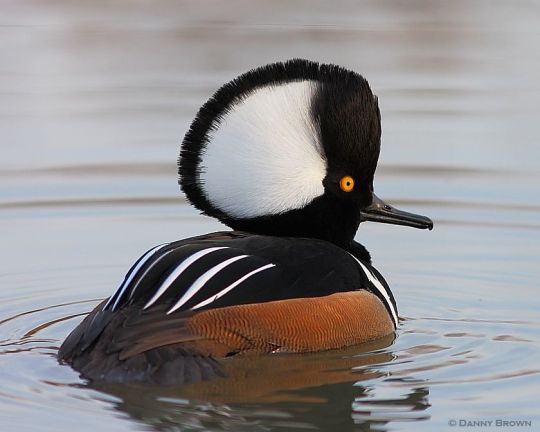

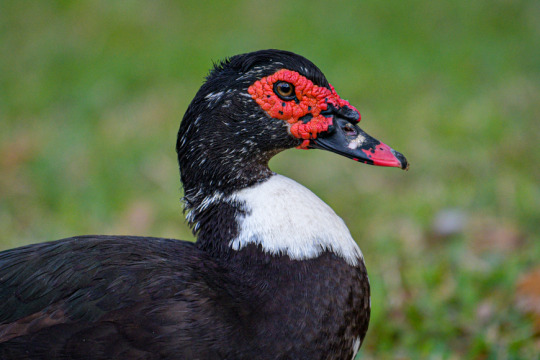

daemon roundup: ducks from my birding book i think are cool
HOODED MERGANSER, Lophodytes cucullatus
Bio: The hooded merganser is a species of diving duck that feeds primarily on aquatic insects, crayfish, and small fish. Notably one of the few species of diving ducks that hunt fish, they have exceptional eyesight that has adapted to hunt underwater and they propel themselves along with their feet. They're named for their crests which can expand and fan out (like the picture above) particularly when courting females. These ducks are found in wetland forests as well as ponds and lakes, though their highly specific diet makes them sensitive to deforestation and water pollution. They're short-distance migrants and will form monogamous pairs during breeding season, and are commonly seen roosting in large groups.
Traits: The hooded merganser soul is a bold, determined individual. They’re gregarious and socially tolerant, and as such are the type of person to feel at home in a group or by themselves, so long as their freedom of expression is not restricted. A hooded merganser does not mince words. They have a very strong sense of self and their image, and they strive to meet it. Their sense of pride comes from their achievements and recognition of them; for this reason, they are typically independent workers, reveling in the thought and execution of their ideas, and savoring the outcome. They’re absolutely ambitious and the type to have big ideas and follow through, though the ends tend to justify the means for them, and they have no issue with cutting corners or picking up work that others have started to make their dreams happen. This definitely gives them a headstrong and competitive reputation. In combination, it’s easy to imagine that a hooded merganser soul can get “blinders” on and struggle to acknowledge others’ contributions or perspectives outside their own. Their energy is in quick bursts rather than patience. They may be prone to rashness or sudden impulsivity when they find an opportunity; their quick-thinking is both a strength and weakness. The hooded merganser’s bold and ambitious energy within their own niche may surprise others when they realize how sensitive they are. They’re not terribly adaptable people and tend to trip over their own feet when suddenly they have to plan rather than rely on their honed instincts. They don’t like going into things blind or making a fool out of themselves, and do the best when their large spirit can shine in their favorite activity.
SURF SCOTER, Melanitta perspicillata
Bio: These beautiful sea ducks are commonly seen floating on the water's surface and then diving for their prey. Their diet consists primarily of mollusks, crustaceans, and pondweeds. They are molt migrants: after nesting on freshwater lakes, they'll fly to sheltered waters where they congregate in flocks of thousands among ocean coasts and bays. Their flight feathers will molt leaving them flightless for a period of about a month. Pairs are formed monogamously and they have high fidelity of nesting areas. Interestingly, chicks will sometimes move between broods, for they feed independently and only rely on their mothers for protection and leading them to food-rich areas. They're rather silent birds and typically only vocalize during courtship and alarm calls.
Traits: The surf scoter soul is a mostly tolerant, internal individual. They tend to be most comfortable in a group or among like-minded companions, as they have a vulnerable streak and derive confidence from being surrounded by support. It can therefore be easy to mistake this person as a wallflower among a crowd, while nothing could be further from the truth. While not the most adaptable of individuals, they have highly independent and keen minds. Surf scoters are opportunistic and flexible thinkers within their comfort zone. They enjoy solving problems and don’t require recognition to appreciate their successes. In fact, teamwork isn’t terribly natural to them. They’re the live and let live sort, and even their closest friends might find them distant, just because the surf scoter appreciates space to explore themselves and assumes others do as well. Perhaps surprisingly then, they’re also quite protective. They are the type of person who gets quietly attached to people and spaces, and this typically quiet soul will come to life when that is threatened. These sudden bursts of emotion can be unanticipated by those around them: their habit is to bottle up their feelings and perhaps not even be completely conscious of it themselves, until it reaches a boiling point and comes free. They tend to get lost in their ideas. They’re absolutely a work smarter not harder kind of person, and will not keep persisting with something if it’s not working, preferring to drop plans that aren’t panning out. Curious and determined, these individuals exhibit a focused drive and quiet willingness to succeed.
MUSCOVY DUCK, Cairina moschata
Bio: The muscovy duck has both a domesticated and wild variant, the former of which is only found in southern Texas and northern Mexico. They're one of the oldest domesticated fowl species, notably kept by the Aztecs and native people of Peru and Paraguay. Both wild and domestic variants are large birds; they have strong claws to perch in trees as well as dabble in wetlands, ponds, and lagoons. They're non-migratory and forage by grazing or catching small fish, amphibians, reptiles, crustaceans, and insects in shallow water. They're an aggressive species that will fight over food, territory, and mates. Males impress females by raising their large crests; they don’t form monogamous pairs and many females will mate with the most desired male, though adults will communally protect chicks. They're very hierarchical and communicate in a variety of ways, including tail waggling, crest raising, hissing, quacking, and head bobbing.
Traits: The muscovy duck soul is extroverted and impressive. At their best they’re confident and bold, though their important sense of self-image makes them prone to feelings of inadequacy if they don’t meet their own expectations. They’re highly sensitive to group feedback in both a good and bad way: recognition and praise makes their day, while criticism causes them to wilt and push themselves harder. They’re very socially shrewd and observant when it comes to hierarchies. The muscovy duck likes to know where they stand among others and feel secure in their place. They don’t do well alone and can be prone to insecurity and self-doubt when by themselves, but they truly blossom among others, and strive to make themselves valued and included among their friends. They put a lot of stock in success: they like to be acknowledged and needed, but they want to do it their way. The muscovy duck can absolutely be hard-headed and stubborn. While they’re very flexible, they’re not the most open-minded and find that the best ideas come from their own head. They have no issue with communication — these people happily tell others when they’re appreciated, and when they’re wrong. The muscovy duck can therefore be blunt and dish it out better than they can take it so to speak, but their inner strength makes them excellent at bouncing back. They are not put down for long, and failures tend to just fuel their drive for success. Their energy makes them boisterous, talkative companions, most typically the natural leaders of friend groups who relish being included.
KING EIDER, Somateria spectabilis
Bio: An arctic duck, the king eider is best recognized for its colorful bill plate. They are highly adapted for the freezing temperatures due to the layer of down beneath their feathers that traps air to help it retain heat and maintain buoyancy. They'll form large flocks on frigid coastal waters consisting of thousands of birds. The king eider hunts both in the open ocean and in shallow tundra lakes. At sea, they dive up to 150 feet to the sea floor to feed on benthic invertebrates as well as mollusks, crustaceans, and urchins. During the breeding season, they’ll dabble in lakes and sein to catch small invertebrate prey. They are more isolated during breeding and will form pairs; incubation and chick raising is conducted by both the male and female, and females will sometimes defend chicks communally, though males are not nest territorial.
Traits: The king eider soul is hardy and companionable. These individuals are sociable and highly agreeable; they’re very tolerant of other people and perspectives, and overall are go-with-the-flow types who don’t keep strong boundaries. They’re not terribly hierarchical and among those with duck daemons are one of the least competitive. It can be said then that they’re much more self-focused and concerned with their own well-being. They’d much rather conserve their energy for their own ambitions and visions, though they aren’t pushovers when it comes to something that matters to them, and will clearly get their point across when someone steps over the line. These individuals clearly excel in their sense of resolution and determination. They aren’t easily ruffled; they’re very secure internally, and proud of their hardiness. When it comes to their work, they put their all into their efforts, and have an excellent sense of ambition and opportunism. King eiders are self-driven and flexible thinkers, and have incredible endurance when it comes to pursuing things. Their enduring demeanor makes them naturals at managing difficult situations while maintaining their inner determination — tolerant and focused, they know their expertise speaks for itself. While not cold by any degree, like other sea bird souls the king eider isn’t known for their teamwork, though is tangentially supportive to their friends who needed. They have a mature perspective on life and enjoy fending for themselves.
28 notes
·
View notes
Text
We are driven by forces we cannot control to return home and take a wife. Or die. — Spock (TOS: “Amok Time”)
My contribution to the @trektribute zine.
Every seven years, all Vulcans are compelled to return to their native planet to engage in the ancient ritual of pon farr or die trying (TOS: “Amok Time”; “The Cloud Minders”). Among fans - and some writers of the series itself, if the odd Tumblr post is to be believed - the most contested feature of this unusual mating system is the suggestion that they only mate once every seven years. However, as a biologist, far more remarkable is the fact that any Vulcan who fails to mate dies. From an evolutionary perspective, it’s astounding that such a system could possibly evolve, but there are some possibilities.
Before I go any further, I should clarify that I will only be discussing Vulcans as they appear in Star Trek: The Original Series. I’m certain there’s fruitful discussion to be had about Vulcans across the Star Trek franchise, but I will exclusively be looking at what’s presented in the original 79 episodes.
First, the most pressing question; why only every seven years? Obviously, there are narrative reasons a writer may want to change this. Even The Original Series, which introduced the Vulcan mating system, seemed conflicted about it (TOS: “The Cloud Minders”). However, as a biologist, that Vulcans only mate once every seven years is perhaps the most normal thing about their reproduction. Humans are one of relatively few species on Earth that reproduce year round. Most species only mate during a particular time of year when there are enough resources available not only for survival, but also for the production and care of offspring (Wingfield & Kenagy, 1991). It makes sense that Vulcans, which live on a desert planet, would have more constraints on when they can reproduce.
Mating every seven years may sound strange, but there are species that reproduce on multiple year cycles; thirteen- and seventeen-year cicadas (Williams, 1995) are probably the most well known. Alternatively, it could be that “the seven-year-cycle” (TOS: “The Cloud Minders”) is measured in Earth years, and is actually one year on Vulcan, or is some equivalent ecologically relevant unit. Being entirely celibate outside of the mating season is also fairly typical. For example, birds that reproduce only once a year often have testes that regress for the rest of the year, making it physically impossible for them to mate - not to mention the hormonal changes that make them no longer have any desire to (Wingfield & Kenagy, 1991). This makes evolutionary sense because if you’re putting a lot of energy into a big reproductive bout, it would be a waste to expend some of that energy on other times of the year when offspring are less likely to survive.
Somewhat more unusual, however, is that it appears that Vulcans’ mating cycles are not synchronized. While Spock is obviously in the throes of plak-tow - blood-fever; the “madness” that precedes pon farr - none of the other presumably mature Vulcans present at his pon farr exhibit any of the same symptomes (TOS: “Amok Time”). Different members of a species mating at different times is uncommon in nature (but not unheard of; Wingfield & Kenagy, 1991) because it makes it difficult for them to find another individual who is also ready to mate. More often, in the wild, variation in when individuals are ready to mate is likely to cause one species to split into two because individuals will only mate with those that are ready at the same time, effectively isolating the two populations and enabling them to differentiate (Taylor & Friesen, 2017). However, like Humans, Vulcans engage in prolonged courtship (TOS: “Amok Time”), so they don’t have to go through the process of finding a mate when they enter pon farr, and unlike the aforementioned birds, they appear to be physically capable of mating even when it’s not their time, so the partner that isn’t going through pon farr can still be receptive. It may be that the environment on Vulcan is harsh enough that the optimal strategy is to mate at a different time from everyone else to minimize the amount of competition your offspring will face.
So far, everything has been fairly straight forward. As a biologist, the really strange thing about the Vulcan mating system is that they mate or die. In the episode, “Amok Time” (TOS), Spock compares this to the salmon, which, when it is ready to mate, leaves the ocean, and “must return to that one stream where they were born, to spawn or die in trying.” This is a pretty analogy, but it leaves out a very important detail; the salmon that mate die too, just perhaps a little bit later. There are many species that use up all their resources on one mating attempt, and then die; salmon, cicadas, many species of butterflies, the list goes on (Young, 2010). There are entire families of moths that stop eating entirely when they reach sexual maturity and just mate until they run out of reserves (Janzen, 1984). This may seem a little strange; why shouldn’t they try to live longer and maybe have a few more chances to mate? But often, these are species that have a lot of predators or otherwise wouldn’t live very long even if they didn’t spend all of their reserves on reproduction. So, instead of wasting energy on defending from predators or building up their immune systems, they just use it all on one big reproduction attempt.
Clearly, Vulcans do not do this. If they successfully mate, pon farr ends and everything returns to normal so they can try again in another seven years. This makes sense; Vulcans generally live long lives and should have many opportunities to mate. Then why do they die if they don’t mate? To my knowledge, there are no species on Earth that die only if they don’t successfully mate. There shouldn’t be because they don’t have any offspring and dying ensures that they’ll never have any more, so there’s no one to pass on their genes. Before I go any further, first I should clarify an assumption I’ve been making implicitly this whole time. For a trait - which could be as simple as eye color, or as complicated as a whole mating system - to evolve, it has to be genetically heritable. That is, there has to be some gene - or often, many genes - that code for it, that are passed down from parent to child (Dawkins, 1976). I’ve been assuming that the Vulcan mating system is composed of genetically heritable traits, which is assumed to be the case of any biological mating system (human mating customs notwithstanding).
To determine whether a genetically heritable trait, such as reproducing or dying could possibly evolve, biologists often imagine what would happen to a single individual with the trait that suddenly appeared in an otherwise identical population of individuals without the trait. So, suppose we have a population where individuals have the opportunity to mate every seven years, but if they don’t mate, they just keep living. Then, suppose an individual is born with a mutation that makes it so that if they don’t mate, they’ll die. If they enter pon farr for the first time and don’t have a mate, they die right there and the trait dies with them; they never get to pass on their genes for mating-or-dying. However, even if they do manage to mate that first year and have a child, and maybe even mate the next year too, they’ll still, on average, have fewer opportunities to mate and therefore have fewer children than their neighbors who can go a pon farr without mating and survive to try again in seven years. It may seem like a small difference, if our mutant only has four children before they don’t have a chance to mate and their neighbors have an average of five, but over evolutionary time, even such a small difference is likely to drive a trait to extinction.
The only purely biological explanation I can think of for the evolution of this strange mating system is based on one of the many hypotheses for why aging may have evolved (Bourke, 2007). The idea is that if an individual doesn’t mate one year, they’re not very likely to have a mate the next year either, or the year after that. This sad, lonely Vulcan has probably had all the children they’re ever going to have; at this point their remaining fitness is close to zero. However, they may have some relatives - children, or siblings - who share some proportion of their genes - children, for example, receive half their genes from each of their parents. If this lonely Vulcan happens to have the gene for surviving, whether they reproduce or not, they’ll continue to consume resources that could be used by their children or siblings who may still have a chance of reproducing. If, on the other hand, this lonely Vulcan instead had the gene for dying when it failed to reproduce, their siblings or children would get those resources and would therefore have an even higher chance of reproducing in the future and having more offspring, and, most importantly for evolution, passing on the lonely Vulcan’s genes, including the genes for dying if they don’t reproduce. This could be especially powerful on a desert planet, like Vulcan, where resources are presumably scarce.
This is also a valuable lesson in why we shouldn’t let evolution dictate how we live. Just because I’m never going to have children and therefore have no fitness doesn’t mean I should die, even if it would help my relatives have more children. Reproduction is so important to evolution because it’s how genes are passed on, and that’s what evolution is; the change in gene frequencies in a population. However, in life, there are things that are a lot more important than gene frequencies.
Now, back to the lonely Vulcan; this explanation may sound all fine and good from a theoretical evolutionary standpoint, but it doesn’t actually work with other things we know about Vulcans. I mentioned that it’s based on an explanation for why aging evolved; the idea is that animals die of old age to give their younger relatives a better chance of surviving and reproducing (Bourke, 2007). Therefore, we’d expect that if Vulcan doesn’t have the resources to support individuals who don’t have mates, it certainly wouldn’t be able to support individuals who are too old to reproduce. It may seem strange, but Humans are one of very few species on Earth that have menopause - i.e., a time when individuals are still alive, but no longer reproduce. One theory for how it evolved is for almost the opposite reason of aging; after a certain age, individuals’ genes are passed on more effectively by staying around and helping care for grandchildren than by having children of their own (Johnstone & Cant, 2010). However, this can only happen if there are enough resources around to support all three generations at once. Even though Vulcan is relatively inhospitable, it seems like Vulcans do still exhibit something like menopause. I doubt Spock was still going through pon farr every seven years by the time he crashes into the alternate universe (“Star Trek” 2009). If Vulcans have evolved to stop reproducing within their lifetimes, then it doesn’t make any sense for them to die after a single failed reproductive bout.
In that case, we need an alternative explanation. I said my first hypothesis was the only purely biological explanation I could think of; to try again we need to delve into the realm of culture. Many animals are capable of social learning, but none on Earth exhibit culture to quite the same extent as Humans. At this point, Humans evolve in a context that is, in many ways, shaped more by culture than nature (Richerson & Boyd, 2004), and like any proper species of humanoid aliens on Star Trek, Vulcans are the same. And, lucky for us, Vulcan culture is by far the most clearly defined alien culture introduced in The Original Series. They value logic to the point of rejecting all emotion and are particularly ashamed of their mating drives (TOS: “Amok Time”). It is not much of a stretch to think that if they didn’t have to endure pon farr, Vulcans would not mate at all. That cultural climate could easily be enough to result in the evolution of increasingly powerful mating drives, as only those with the strongest desire to mate would have any offspring. Eventually, it appears that Vulcan culture became so strict that the only way they would mate is if they would die otherwise.
This is consistent with what little evidence there is in The Original Series of what Vulcans were like before they adopted such a strict philosophy. The Romulans, who split off from the Vulcans around the time their philosophy of logic became widespread, appear to be more similar to humans; when Spock attempts to woo a Romulan commander to infiltrate her ship in “The Enterprise Incident” (TOS), she seems to have some physical interest in him. Even stronger evidence of what Vulcans were like historically comes in the episode “All Our Yesterdays” (TOS), where Spock reverts to behaving like an early Vulcan - for perhaps less than adequately explained reasons - which includes a strong sex drive even outside of pon farr, suggesting that their mating system has changed significantly in somewhat recent history. This is not to say that the evidence is conclusive; to determine that we would need to conduct an empirical experiment, which is unfortunately impossible, but this theory seems to present a promising explanation of the facts.
References
Bourke, A. F. (2007). Kin selection and the evolutionary theory of aging. Annual Review of Ecology, Evolution, and Systematics, 38, 103-128.
Dawkins, R. (1976). The selfish gene. Oxford University press.
Janzen, D. H. (1984) Two ways to be a tropical big moth: Santa Rosa saturniids and sphingids. Oxford Surveys in Evolutionary Biology, 1, 85–140
Johnstone, R. A., & Cant, M. A. (2010). The evolution of menopause in cetaceans and humans: the role of demography. Proceedings of the Royal Society B: Biological Sciences, 277(1701), 3765-3771.
Richerson, P. J., & Boyd, R. (2008). Not by genes alone: How culture transformed human evolution. University of Chicago press.
Taylor, R. S., & Friesen, V. L. (2017). The role of allochrony in speciation. Molecular Ecology, 26(13), 3330-3342.
Williams, K. S., & Simon, C. (1995). The ecology, behavior, and evolution of periodical cicadas. Annual Review of Entomology, 40(1), 269-295.
Wingfield, J. C., & Kenagy, G. J. (1991). Natural regulation of reproductive cycles. In Vertebrate endocrinology: fundamentals and biomedical implications, 4(Part B), 181-241.
Young, T. P. (2010) Semelparity and Iteroparity. Nature Education Knowledge 3(10), 2
6 notes
·
View notes
Text
Spectember Interlude: Mr. Dixon's Wild Ride
The rhinogrades were the start of larger-scale speculative evolution works, but what truly popularized the genre to the general public are undoubtedly the works of Scottish geologist Dougal Dixon.
His 1981 book After Man was a "zoology of the future" using over a hundred speculative species to demonstrate the principles of evolution. Set 50 million years from now in the world of the Posthomic period, humans are long gone and the hardy survivors of a prior mass extinction have diversified and convergently evolved to fill vacant ecological niches, including rabbits becoming ungulate-like animals, penguins becoming giant whale-like creatures, and rats taking on the role of canid-like predators.
Some of the more outlandish creations have become infamous over the years and may seem cliché by modern standards – like the giant flightless predator bats – but when it was first published it was revolutionary, and there's still a certain charm to it all even if the artwork isn't quite as good as it could have been. Despite Dixon himself being a talented artist, the publisher chose to have all the final images created by other illustrators based on the original concepts. (And the updated 2018 edition goes as far as replacing a couple of images that the author was especially unhappy with.)
The success of After Man led to two "sequels" a few years later. In 1988 The New Dinosaurs took the premise of the K-Pg mass extinction never happening and used "an alternative evolution" to explain the geographical distribution of species. Inspired by the dinosaur renaissance, some of its fictional creations arguably predicted later paleontological discoveries – many species are depicted as extensively fuzzy (including ornithischians!) and aren't too terribly shrinkwrapped for the time, and there are then-unknown concepts like small arboreal climbing theropods, giraffe-like ground pterosaurs, and semi-aquatic beaver-like mammals coexisting alongside the dinosaurs.
But at the same time much of it just hasn't aged very well, with a lot of the paleontological basis of the The New Dinosaurs having become horrendously outdated over the last thirty years. Many of the species are also rather lumpy-looking and unappealing, and some are just direct stand-ins for recent mammals. For example, Australia is home to both kangaroo-like and koala-like dinosaurs for no apparent reason other than Australia just being Like That, and South America features very specific anteater, manatee, glyptodont, and sabertooth predator analogues.
Then came Man After Man in 1990. Initially intended to be a direct sequel to After Man, Dixon's original concept would have shown the impact of humans arriving in the Posthomic period, escaping their dying overpopulated civilization by time-traveling into the far future and promptly causing ecological devastation and a mass extinction all over again.
But that was not to be.
Instead the publisher pushed Man After Man in a very different direction, and it became an "anthropology of the future" chronicling the evolution of post-human species genetically engineered to adapt to climate change. Rather grotesque and full of dystopian nightmare fuel, even Dixon himself has called it "a disaster of a project".
(It also suffers from what may be plagiarism, with some of the designs looking worryingly close to those of another project that had been pitched several years previously by Wayne Barlowe. It remains unclear how much involvement and control Dixon actually had with Man After Man after the drastic change in concept, or whether he was even aware of this similarity.)
Some of Dixon's works became especially popular in Japan, with After Man being adapted into both a stop-motion documentary and an animated short, and even having merchandise, and a manga version of The New Dinosaurs.
Later Dixon was a consultant and creature designer on the 2002 documentary series The Future Is Wild, a sort of "spiritual successor” to After Man – although due to the rights to After Man being held by Dreamworks at the time, none of his previous creations could be used. Depicting various ecosystems 5 million, 100 million, and 200 million years in the future, this series featured memorable speculative species such as whale-like gannets, giant carnivorous bats, sauropod-sized tortoises, four-winged birds, aerial fish, and arboreal squid.
The Future Is Wild was also adapted into both a manga and a Canadian-produced animated children's series. There were plans over the years for a sequel documentary series, a feature film version, and then more recently a full reboot (including that VR game with the questionably-designed titan dolphin), but all seem to have succumbed to development hell.
Eventually Dixon's original premise for Man After Man was reworked into Greenworld in 2010 (so far only ever published in Japanese), using his own artwork and changing the setting to an Earth-like exoplanet populated by animals descended from radially-symmetrical starfish-like ancestors. A generation ship carrying thousands of humans fleeing a devastated Earth arrives to colonize the planet – and over the next few centuries they repeat history by exploiting the native lifeforms and putting Greenworld through multiple ecological catastrophes, causing a mass extinction that leaves the entire biosphere in ruins.
At some point another project called Microplatia was also developed for a planned exhibition on alien life at the Science Museum in London, but due to sponsorship issues was never completed.
Tomorrow: an expedition to a different alien world.
#spectember 2020#spectember#spectember interlude#speculative evolution#specevo#dougal dixon#after man#the new dinosaur#man after man#the future is wild#greenworld#microplatia#long post
107 notes
·
View notes
Text
March 2, 2021: The Last Unicorn (1982) (Part 1)
I, uh...I wanna talk about zoology.

It’s my profession of choice, although if I’m going to be specific, it’s ecology and ornithology, based on my Masters. But while my expertise is in birds, that doesn’t mean I have any particular preference. So, let’s talk mammals. Specifically, I’d like to talk about horses.
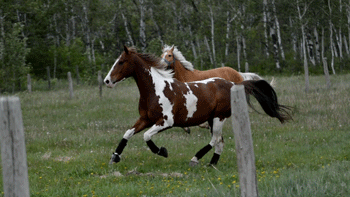
Horses are odd-toed ungulates (Order Perissodactyla) belonging to the family Equidae, with only one living genus (Equus), which includes donkeys, zebras, and a FUCK-ton of fossil progenitors. Not gonna go into horse evolution here, since it’s a vast topic on its own, but the group dates to about 54 million years ago, during the Eocene period.
There are specific features that define modern horses as horses, including a single hoofed toe for walking on, a body built for running with high stamina, and a large cecum in the intestines for breaking down fibrous and herbaceous material. It’s a group native to North America, Africa, and Asia, with the modern descended horse descended from a somewhat unknown ancestor in Central Asia.
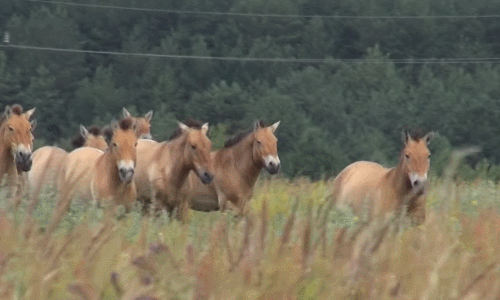
They’re grazers rather than browsers, which many similar sized herbivores are. And, of course, they have a close relationship to humans throughout prehistory. Their main systems of defense against predators are the afore-mentioned running capabilities, a VICIOUS kick (especially horses like zebras), and a high-range of monocular vision due to the position of their HUGE eyes.
In terms of sexual selection, it’s essentially based on physical competition between the males in a population, which are usually formed into reproductive harems. That’s one male with multiple females that live within an established range. The females have their own dominance schemes, while groups of males exist in bachelor herds before establishing a harem of their own.
And those two paragraphs help explain why horses don’t grow horns.
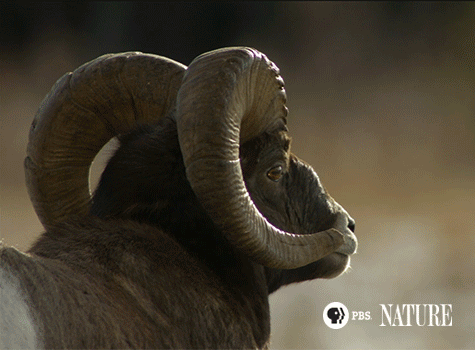
Animals like this bighorn sheep, as well as antelopes with impala and gerenuk, perform intrasexual selection using their horns, the size of which determine the fitness of an individual male, with the fights settling any potential ties for watching females. And that’s the main reason why herbivorous mammals grow horns, and horses have come up with different social structures to compensate. But OK, couldn’t they just horns anyway?
Remember the stomach I mentioned earlier? Here’s the thing; hindgut digestion, which is what horses do...not the most nutritionally efficient form of digestion. In order to maintain their running lifestyles, they invest all obtained energy and nutrients into building muscle and other important functions. Fact of the matter is, they just can’t devote enough energy and nutrients to the physiologically expensive act of owning a horn. They do have a close relative that does that, though. However, they’ve sacrificed their speed, intelligence, and even their eyesight for their horns, as well as beefing up their physical defense with thicker skin.
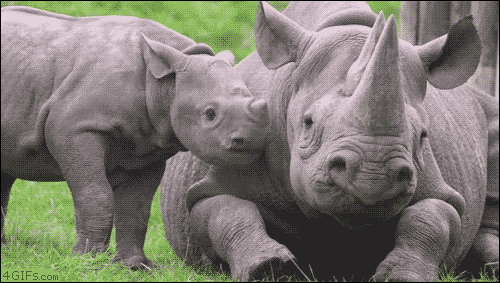
YUP! So why talk about this? I mean...you know why.

OK, so that had basically nothing to do with this movie, but a post like this has been building since I mentioned the gerenuk a little bit ago. Sorry, had to get it out. Anyway, yeah, unicorns are impossible, but they’re still a hallowed mythical creature. National animal of Scotland, one of the most prominent symbols of medieval mythology, a magic-using ethnic class in a mythical kingdom composed of a horse-based majority that also includes normal horses and pegasi...

You know, unicorns. So, I’m definitely interested in what would happen to make a unicorn, well...the last one. My bets are on something man-made, like deforestation or another for of habitat depletion. Could be poaching for the horn. After all, that’s what’s been driving rhinoceros species to near-extinction (or actual extinction in the case of the western black and northern white rhinos. RIP Sudan, you goddamn king).
But let’s find out rather than speculate! SPOILERS AHEAD!!!
Recap (1/2)
During medieval times, in a mystical wood called the Unicorn’s Forest, a hunter shows unease to his companion. In the forest, there are no seasons, and the beasts are protected from hunters, as long as there is one unicorn left if the forest. That last unicorn is...the Unicorn (Mia Farrow), who learns from the hunters that she must be the last of her kind.
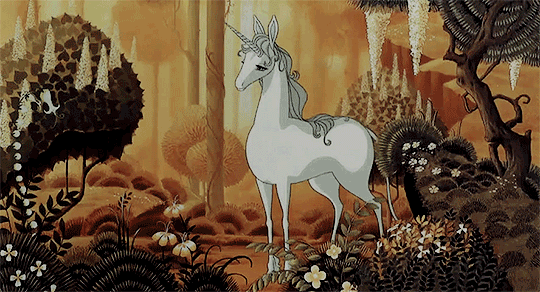
The opening credits, which are a gorgeous animated medieval tapesty, are backed by the song “The Last Unicorn”, by America (damn, nice pull). Gives the whole thing a Renn Faire feel. Never been to a Renn Faire, but I’d love to go to one, honestly.
Anyway, the Unicorn is in doubt that there are no more of her kind in the world, as they live forever, and she would know if there are none left...right? However, they can also be killed and trapped, so...I mean, they might be dead, Unicorn. As she’s thinking on this, the most Rankin-Bass butterfly ever shows up singing a ballad of love. This is...the Butterfly (Robert Klein), a bard-erfly (see whay I did there) who won’t stop singing, despite the Unicorn’s pleas to tell her of other unicorns.

Butterflies, apparently, repeat to anything they hear around them Which involves like, a lot of non-medieval songs. There’s one about the A-train, apparently, which makes...just NO fucking sense. As the Unicorn also shows frustration at this anachronistic little bugger, he breaks his songs to tell her than the Unicorns have all been chased off by “the Red Bull.”
...I’m going to hold it off as long as I can, but the joke WILL come. It WILL come.

She wonders if she can truly leave the forest, then actually does so in order to find the other unicorns. She happens upon a farmer, who attempts to tame her, as he only sees her as a horse. Apparently, men can no longer see unicorns as they are, and usually only see them as white horses. So, there may be unicorns in the world after all!
Not sure why she doesn’t go back to her forest after realizing this, but...OK. She continues on, backed once again by a song performed by America, called “Man’s Road”. Real talk, I’m digging the music in here, which is my inner folk rock fan talking.

While she finds nothing on her journey, she’s instead found by Mother Fortuna (Angela Langsbury), a witch who runs a carnival that needs a new exhibition. With her comes Ruhk (Brother Theodore) and magician Schmendrick (Alan Arkin), the latter of whom actually can see the Unicorn as a Unicorn.
At the carnival, Schmendrick introduces hiself to the Unicorn, wanting to get her out of there. Meanwhile, an audience is fooled by Mother Fortuna’s illusory magic to see a manticore, satyr, and the Midgard Serpent, when in reality they are an elderly lion, ape with a twisted foot, and really sad snake. However, the Harpy that she has IS real, and a major threat to Fortuna were she to escape.

That night, Fortuna speaks to the Unicorn of the Red Bull, owned by a King Haggard. The Unicorn asks Fortuna to free both her and the Harpy, two signs of the same magical coin. Also...is this a kids’ movie? Kinda thought it was until I noticed that the Harpy has, well...pendulous breasts. Literally the best way I can describe them. Also, three of them, so...there’s that.

After she leaves, Schmendrick arrives to free the Unicorn with his magic...and he’s shit at it. Like, REALLY shit. But thankfully, he’s a decent pickpocket, and stole the cage keys from Ruhk. He lets the Unicorn free, and she in turn releases the other animal prisoners, Harpy included. Which is NOT great for Fortuna, who’s IMMEDIATELY killed.
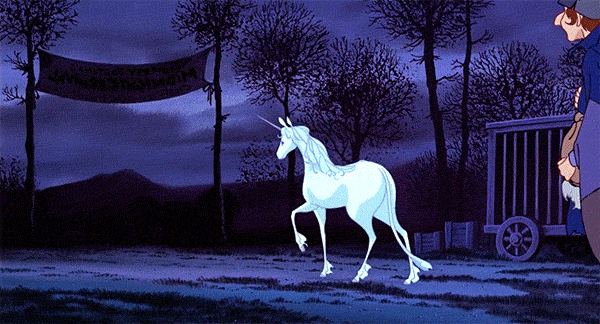
The two leave together, and head on the Unicorn’s journey to find her own kind. She cannot grant Schmendrick his wish to become a true magician, but he still gives her information about this world, and King Haggard, who seems like bad news.
On the road, the two encounter a gang of thieves of the road, who work for Captain Cully (Keenan Wynn), a short and portly leader of bandits. His mistress is a woman named Molly Grue (Tammy Grimes), who’s endlessly frustrated by Cully’s regular failures. They befriend Schmendrick, who impresses them with illusions of Robin Hood and his Merry Men. Although, it’s not his illusions, but those of the Unicorn, trying to help.
Doesn’t help that much, though, as the Robin Hood-hating Captain Cully ties him up to a tree after all of his men and Molly leave. A frustrated Schmendrick mutters a spell by mistake, and brings the tree to life.
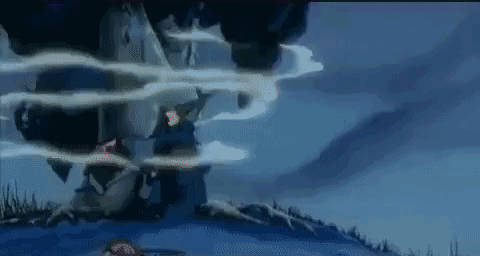
And then my girlfriend fuckin’ broke. Here she is, below:

Ravishing. Yeah, she’s watching this too, and when the tree came up, her words were, and I quote:
...a smooth-talking horse, a three-tittied harpy, and a BOOBED TREE!
Boobed tree is an expression I will find a way to use in my life. Also, this is ABSOLUTELY not a kid’s movie, and that is one busty-ass tree. This tree, called...The Tree (Nellie Bellflower) is in love with Schmendrick, and is enraged by the appearance of the Unicorn. However, the Unicorn undoes Schmendrick’s magic, and puts the t-horny tree back to sleep.
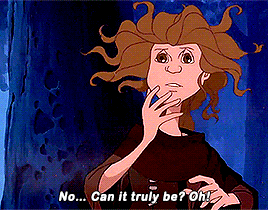
The two encounter Molly Grue, who’s astonished to see a Unicorn. She cries, as she was been waiting to see one since she was a young maiden, but now she isn’t one anymore. Interesting implications there, but moving on. Molly wishes to join them, and while Schmendrick isn’t super down for that, she wins the Unicorn’s trust when she points out that they’ve been going in the wrong direction. Whoops.
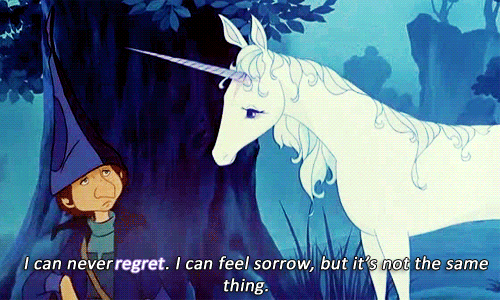
OK, with that, let’s break for Part 2! See you there!
#the last unicorn#peter beagle#arthur rankin jr.#jules bass#rankin bass#rankin-bass#alan arkin#jeff bridges#mia farrow#tammy grimes#robert klein#angela langsbury#christopher lee#keenan wynn#paul frees#rene auberjonois#the unicorn#user365#365 movie challenge#365 movies 365 days#365 Days 365 Movies#365 movies a year#mygifs#my gifs
13 notes
·
View notes
Photo










Science Saturday: The Naturalist’s Library
Today we revisit the mid-19th century series The Naturalist’s Library, published in Edinburgh from 1833-1843 by William Home Lizars and edited by Sir William Jardine. The series is made up of 40 volumes, and each volume covers a topic related to one of four groups: birds, mammals, fish, and insects. Every volume in the series includes a short biography of a prominent naturalist. The rest of the text is dedicated to information about notable species, and features 30-35 hand colored steel engravings. Most of the illustrations were done by the artist James Hope Stewart and engraved by the publisher William Home Lizars. What I love most about this series is that is was meant to have wide appeal and it was very affordable compared to other illustrated natural history works at the time.
Today’s volume is a book about mammals, specifically primates! It includes a portrait and biography of the French naturalist Georges-Louis Leclerc, Comte de Buffon.
The introduction of the book reads:
“Natural History of Monkeys: Among the varied races of living beings which inhabit this world, none perhaps have excited so much speculation and general interest, as those to which we have devoted our present little volume. From the shy and retired manners of the animals in a wild state, their habits are of difficult investigation, and would require much patience, and a greater allowance of time, than it is often possible for those individuals who posses the enviable opportunities, to devote to them. The greater portion of the information we possess, is therefore derived from the accounts of travelers, too often collected from hearsay evidence, exaggerated as the fears and superstitions of the natives have been influenced, and which have appeared as ‘dreamy forms.’”
A couple things are notable about this passage. First, that a lot information about animals outside of Europe was coming second hand from explorers to previously unknown places, often made possible by colonialism. It also exhibits the Eurocentric view that indigenous populations were not ‘scientifically’ knowledgeable in their local nature. The animals in these books were often based on specimens brought back to Europe. The editor of The Naturalist’s Library, Sir William Jardine had over 10,000 specimens of birds and other animals in his personal collection. When looking at the last picture of ‘Midas leonina’ [Pygmy marmoset] it seems like an imagined creature! According to the text it was based on a specimen and not a field drawing.
The Naturalist’s Library was found in our sibling department, The American Geographical Society Library, a premier geography research library at UW–Milwaukee. View our first post about it here.
View other Science Saturday posts.
–Sarah, Special Collections Graduate Intern
#The Naturalist’s Library#Science Saturday#William Home Lizars#Sir William Jardine#James Hope Stewart#Georges-Louis Leclerc Comte de Buffon#scientific illustrations#primates#mammals#monkeys#AGSL#The American Geographical Society Library#hand colored plates#Science Saturdays#engravings#steel engravings#natural history#Sarah Finn#sarah
52 notes
·
View notes
Note
What is your opinion on The Crazy Pigeon Lady on youtube? Also I'm sorry for what you're going through, hope you get through it just fine.
OohI looked her up, and thus far like her over all.
We have a few differences, but they are thus far location relevant.
In the first episode, she discusses the difference between a pigeon and dove from a purely taxonomical and linguistic stand point, with out any apparent regard for the possibility that the person asking may have been asking about how to differentiate between the different domestic species.
It may not have dawned on her that that was a possible aspect of the question.
She is in the UK, where all white pigeons are colloquially referred to as Doves, and colored birds referred to as Pigeons, giving rise to the common misconception that colored and white pigeons are two different species.
In regards to whether or not pigeons are dirty, she defines ferals as “Formerly domesticated, now wild birds” which is not true in North America, because there are no wild populations of rock doves for ferals to get any fresh infusions of wild blood from.
There are unaltered, still wild native Rock Dove populations in the UK with which ferals can interbreed, making them at least some degree of genuinely wild there.
Her answer concerning pigeons as a disease risk was accurate and thorough.
I’m going through their pigeons as pets series, presently.
Episode one revolves around why some one might want a pet pigeons that is very detailed and largely accurate.
She is not correct in Ringnecks or other species of doves having similar temperaments to pigeons, or in them being more than minorly social (other columbid species pair bond exclusively and do not flock year round the way domestic Pigeons do).
I like that she differentiates Pigeon vs. other columbid species cooing. ^v^
I also like that the why you would want one is followed by “here are some potential issues to consider to make sure this will be a good pet for you before you get one.”
She goes into cleaning, briefly, but succinctly.
And a bit about social needs and commitment.
And considering whether or not you want to breed.
Great introduction, with minimal inaccuracy.
Episode Two is focused on selection and aquisition of the bird.
Ooh! She begins by discussing pros and cons both of purchase from breeders and adopting from a rescue.
Most of the pros from a breeder are excellent and correct, but she does mention among the cons “A pigeon purchased from a breeder takes a home away from a rescue, so consider that if that’s important to you”, which is not true, as people choose to go to a breeder or a rescue for entirely different reasons.
A particularly excellent con she mentions of going to a breeder is that breeders tend to breed in very large numbers, and probably won’t have spent any real time getting to know any individual bird, so the individual’s temperament may be a bit of a crapshoot.
This is something we ae trying to change, but is still very much true of the vast majority of pigeon breeders, and is a fantastic point to consider for looking into the acquisition of a pet.
Their pros and cons of adopting from a rescue were accurate and balanced.
And acknowledging that it is a responsible action for a first time pigeon owner to take time to consider whether or not they can care for a traumatized, disabled, or special needs bird is something I greatly appreciate.
She goes from here into pros and cons of different types of pigeons, categorized as Exhibition, performance, utility, and rescue.
Her assessment that healthy performers can’t or should not be kept indoors (only disabled or geriatric individuals) is inaccurate.
As many of you have seen from my own birds, Homers and Rollers can be perfectly happy indoors, so long as they are not caged in anything smaller than a pigeon proofed room.
It is not a requirement that they be allowed free flight outside to be physically, mentally, or emotionally healthy.
Interesting side note: Apparently, meat pigeons eaten in the UK are more often sourced by hunting than farmed, so commercially bred utility birds are not much of a thing there.
She also goes into whether to start with a single bird or a pair, in excellent detail.
She also lays out that housing and a carrier to bring the bird home in should be prepared before going to get the bird.
She discusses checking the claenliness of the breeder or rescues loft (I like that she specifies to also check a rescue’s cleanliness, rather than assuming a rescue will be clean because it is a rescue.)
Her advice to talk to the breeder or rescue is excellent.
And she goes into a lot of detail of what warning signs to avoid while trying to select a healthy bird.
Going into detail about what healthy poop should look like is an excellent and often overlooked addition that I am especially pleased she has not missed.
She even goes into sexing, meds, and vaccinations.
The discussion of acclimating a new bird to the changed environment is excellent.
One week is WAY too short a time to isolate a new bird from previous residents. Most pigeon diseases take two to three weeks to develop symptoms, so my minimum quarantine is four weeks.
Their acclimation advice otherwise is fantastic.
Episode three focuses on enclosures and equipment.
Fantastic point was made that there is not an indoor cage large enough for a pigeon to live in full time, and flight time outside of it is a must for several reasons.
Considerations for what type of enclosure of what size in what location is excellent.
Planning for enclosure maintenance is excellent.
Would have liked for her to have shown the enclosures she uses for her birds, but the descriptions are detailed and accurate.
She includes that perches need to be flat on top and not too crowded or numerous.
Pleased by the recommendation of at least one brick. ^v^
I would not advise lining a pigeon enclosure with a towel, because of the ease with which strings can be picked out of place with their claws in the course of just walking over it, which could tangle around the toes and cut off circulation if the string comes free of the towel or break the toe if it doesn’t, and the tangled bird panics.
Fleece is a safe alternative that doesn’t come apart in full threads and will not tangle this way, if you like the idea of a fabric floor.
She details news paper, puppy pads, wood shavings, and sand accurately.
LOVE that she detailed deep ceramic ramekins as being ideal for water, while preferring shallower ones for food and grit.
aaaand there she goes into what to use to feed greens. >v<
Pigeons cannot digest anything but seeds.
Please do not feed them greens, roots, tubers, stems, flowers, or fruits.
Yes, there are nutrients in those things, but they do the pigeon absolutely no good if they cannot process those items to get to those nutrients.
This is a very common misconception stemming from parrot care.
The discussion of carriers is succinct and accurate.
Gram scales, claw clippers, measuring equipment, and bath dishes were also discussed in excellent detail.
The next does into diet, and I expect to do a lot of yelling about the addition of veggies. >v<
But, at this point, I think I’ve sampled enough to give a verdict.
The vast majority of what I have seen on care of pet pigeons is accurate, and she breaks things down in perfect detail for beginners looking into getting their first pigeon.
There are a few linguistic and location-specific differences between UK and North American pigeons; things that apply in one that do not in the other. For example, meat pigeons being bred for consumption vs hunted, and whether or not ferals can accurately be described as Wild or semi-wild.
One potentially dangerous bedding material being recommended, one misconception about recue versus breeder, and further perpetuation of a very common dietary myth are the only inaccuracies I have seen so far.
This woman pays close attention to her birds, and they are comfortable and happy in her company, which speaks volumes for her relationship with them.
Her advice for starting to build a relationship with a newly acquired bird is absolutely spot on.
If you, or any of my other followers, would like me to continue reviewing her care series on pigeons as pets, or any other pigeon related content, you are welcome to submit videos for commentary in my ask box.
I greatly respect blogs like @is-the-owl-vid-cute and would not mind providing a similar service in regard to pigeons.
46 notes
·
View notes
Text
Animal Crossing Fish - Explained #67
Brought to you by a marine biologist back in freshwater...
CLICK HERE FOR THE AC FISH EXPLAINED MASTERPOST!
Finding a mate is hard. In the animal world, a lot of work is put into attracting a mate. You have to think, with competition basically everywhere, you have to do something to stand out. This kind of competition is the basis for evolution - not only do you have to survive, but you have to survive so well that a potential mate finds it sexy. Today’s fish, the Pale Chub, is trying to do just that:

The Pale Chub is only available during a small portion of the day, but because they are available all year, you’re sure to have caught one by now. Like so many fish in ACNH, the Pale Chub (Zacco platypus) joins the Koi, Carp, the three Goldfish, Crucian Carp, Bitterling, and Dace in being yet another goddamn fish from Family Cyprinidae. Like I’ve already said now six times, this is a very diverse family, holding more members than any other vertebrate family. So explains, I guess? They are very common, shallow-water stream fish, native in China, Korea, Vietnam, and Japan.
Every Pale Chub you catch, though, will be a male in breeding colors. You see, normally the Pale Chub, is, well, pale - they’re a drab greenish gray with silvery scales, but come breeding season, the males change into the beautiful blue and pink you see in the game and below:

His anal fin, the long, flowing fin on his underside, also grows longer. So, yeah, every Pale Chub you catch is an unlucky guy just looking to pick up chicks. Experiments have shown that, although these features are for breeding, it’s actually only the pink color the females are looking for. Nevertheless, the males expend energy to put on a show.
We’ve talked about sexual selection before when we talked about the Guppy, in that some traits are inherited for sexual purposes rather than for survival. This is true in so many species, the peacock being a great example in the bird world. This type of dating scene is called “mate selection”, in which one sex calls the shots and chooses their mate based on some trait or behavior the other has or performs. In the Pale Chub and lots of other animals, breeding is female choice, in which females get final say and are very picky in the males they choose to breed with. Females in the animal world will choose mates based on all kinds of things, from the male’s gorgeous colors, the songs he can sing, the resources he has acquired, how good he’s built a nest, the fights he’s won, etc.
But why do males do all the work? Well, they don’t. Most species have female choice because females ultimately contribute the most energy (for fish, this is in the form of egg production, travel to nursery areas, and/or even parental care) to offspring. Females, therefore, must choose males who exhibit the very best traits (who is the strongest? the fastest? the smartest?) that can be passed on to the offspring. There are some instances in the animal world where these roles are reversed, where females compete for the eye of a male. These species, like sea horses, have parental care from the male, so it’s the male who gets to be choosy.
And there you have it. Fascinating stuff, no?
#pale chub#fish#animal crossing#animal crossing new horizons#science in video games#animal crossing fish explained
11 notes
·
View notes
Text
Fresh Air and Fun at Austin’s Fortlandia
Three Cheers for Lady Bird Johnson! After what feels like eons being stuck inside during Covid-19, the LBJ Wildflower Center is offering visitors the chance to unwind with some outdoor bliss with their annual Fortlandia exhibit.
This special botanical garden and arboretum is located at Austin’s very own University of Texas and features more than 900 species of native Texas plants. This area of Austin is, pardon the pun, ripe with opportunities for curious and academic-minded residents to explore and encourage a sense of scholarly wonder in their families. For members of the apartment community, I find that residents just outside in the Highland Park Court area have an easier time coming over without much traffic. Members of the East Riverside area such as residents in Treehouse Apartments will also find that the commute is fairly painless as well. Of course, students commuting from the University of Texas at Austin in Downtown Austin might naturally have a lot more of a traffic hassle in reaching the center but they’ll still find it a pretty easygoing experience overall. Austin is far less daunting than Houston when it comes to traffic and the city’s more relaxed atmosphere is probably a testament to its overall convenience.
The LBJ Wildflower Center’s Fortlandia is an amazing opportunity to really have some fun in the great outdoors after being cooped up for so long. At this amazing exhibit, guests can view a collection of custom-designed forts as well as build their own. You can also trek along the one-mile trail among the native oaks and natural trees, swing on tree swings, and explore the wide-open spaces of beautiful treeside scenery. It’s a great experience for singles and families alike and I can’t recommend it enough. For all you nature-lovers, this is an experience you just can’t miss!
1 note
·
View note
Text
Jurassic Park - Expanded With Modern Knowledge
I’ve posted a few times now on how to redo Jurassic Park/Jurassic World in terms of Fauna Diversity and other factors. So you can say with this post I’m “Back on my Bullshit.”
Let’s dive right in, shall we? We’ll see some repeats, but others not so much. We’ll go about it via different exhibits: The Primary Tour, The Aviary, the Aquarium, The “Fossil Zoo”, The Feeder Animals, and the WIlds.
The Wilds
There are indeed wild animals in Jurassic Park. In the book, part of the whole thing as the re-creation of an extinct ecosystem. The island Isla Nublar is based on, Cocos Island, is extremely isolated and secluded. Outside of feral animals ( pigs, deer, goats, cats, and rats), there is very little land life. Arthropods (Primarily ants, butterflies, millipedes, centipedes, spiders, and isopods) and 2 species of lizards - an Anole and a Gecko. That’s about it. Other sources say there are other reptiles on the island, but I have yet to find any details beyond that.
Though there are a LOT of birds. 90 species, mostly seabirds using it or the offshore rocks as breeding sites. Endemic birds include a Cuckoo (The Cocos Cuckoo, which is a glorious name a had to share), a finch, and a flycatcher. Most other birds are found elsewhere inland or offshore.
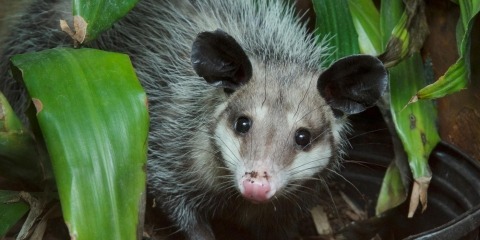
The books add 4 animals to the wilds: frogs, leeches, large tarantulas, and opossum. It acknowledges feral rats, but little else. I’d include them, easily. Several varieties of Opossum, because they are an archetypical “Ancient” mammal. The Common and Virginia Opossum, the Water Opossum, and 2 types of Mouse Opossum are all native to Costa Rica and could easily island-hop to Nublar beforehand, or be introduced for a “Night Safari” element.
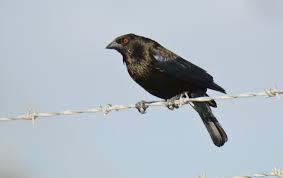

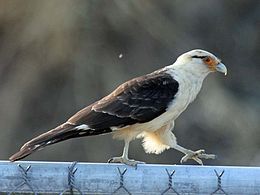
Me? There are 3 birds I’d bring focus to. The Bronzed Cowbird, the Cattle Tyrant, and Yellow-Headed Caracara. All of them follow large animals (or at least, things Capybara sized or bigger) and eat insects disturbed by the larger animals, or that try to feed on the larger animals. All are native to Costa Rica and its surroundings, so with the influx of large herbivores, they are bound to come over. Further, smaller herons and egrets would also take advantage of the larger animal movement disturbing prey.
South America also has its own dung beetles, and I bet a few of them could be called over to all the free food. Most deal with monkey poo, but I doubt they’d ignore the bounties available. InGen may bring in their own to handle the elephant-sized spore, but there will be dung beetles. Lots of them.
Other Costa Rican fauna I’d include as background elements (that could feasibly be on Isla Nublar AND fit the prehistoric aesthetic) include shrews, Central American Agouti, Northern Tamandua, Nine-Banded Armadillo, Brown-Throated Three-Toed Sloth, Hoffmann’s Two-Toed Sloth, and Central American Dwarf Squirrel.
But we also know that InGen released animals into the park that were ‘prehistoric’ to make the whole area support the dinosaurs in some way. This included a (grossly misplaced and oversized) dragonfly/griffinfly.
So, in a more realistic version, what would they do release into the wilds of Isla Nublar?

Tinamous. As I’ve said before, they can easily be in enclosures with larger animals. They’ve been in their current form for about 10 million years, and they resemble ancestral ground birds (the kind that survived the KT Boundary) extremely well.
Capybara. Docile as hell and gets along with everything, as well as attracting the tick-eating birds mentioned above, these animals can chill with the best of them. Plus the genus dates back 3.6 million years, with the subfamily going back about twice that far. They are a bit longer than the largest known Mesozoic mammal (Repenomammus (90cm, 13kg)), growing to 1.3m and 68kg.
The Feeder/Support Animals
In the novel, there are made mention of fish being stocked that the Tyrannosaurs feed on. The Arapaima is about the only fish for that environment (and easily obtainable) that could fit the bill. They also use goats as feeder animals, and in the movie, they use cattle to feed the raptors.
In my take, the carnivorous animals would primarily be fed with fish and poultry. Some smaller ones may warrant mice or rats, but fish would work much better overall. So, Chicken, Turkey, Arapaima, Fathead Minnows, Tilapia, Poecilia, and so on. Given what we currently know about Tyrannosaurs, 6 Turkey a day would be enough to keep it fed (T. rex may need about 40k calories a day to function, and one turkey can provide about 7k calories). Or 5 Arapaima (fish provide 82 calories per 100 grams, and arapaima can get up to 200kg, even assuming 100kg, that’s 8,200 calories per fish).
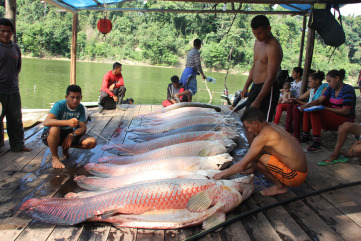
Goats have about 1 calorie per gram, so a goat weighing 40kg (not out of the ordinary as breeds range from 20 to 140kg, but it would be an overall large goat) would meet the dietary needs of a Tyrannosaur.
I’ve already mentioned the cowbirds, but they are pretty important for overall animal health. Because I’m sure there are ticks since the deer got on the island.
The Fossil Zoo
Here are “Living Fossils” and things reverse-engineered from existing animals to be more akin to their prehistoric brethren. As well as their mammalian De-Extinctions. Because some would be rather easy.
Some of the ‘wid’ animals would have an example or two in this more “proper’ zoo environment: Capybara, Agouti, Nine-Banded Armadillo, Tamandua, Sloth, Opossums.
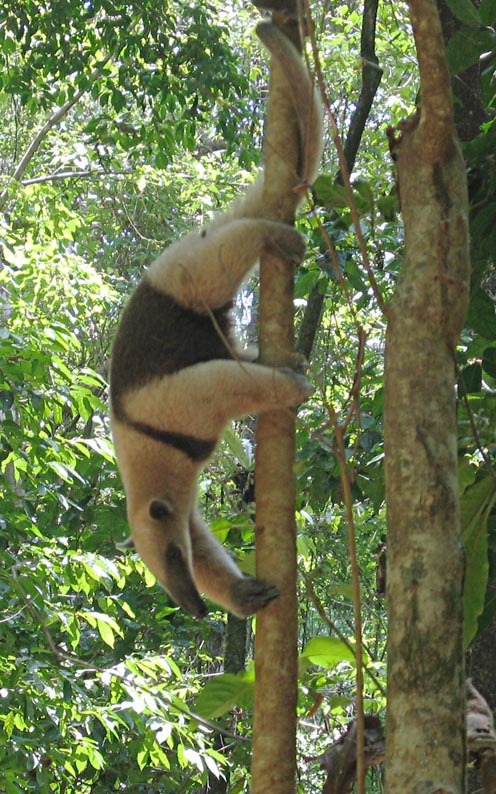
Other mammals of note in this section would be Treeshrews, an Aardvark, Greater Mouse Deer, Black and Rufous Elephant Shrews, A Tapir, Chacoan Peccary, Solenodon, A Giant Anteater, Platypus, Short-Beaked Echidna, and Long Beaked Echidna.

The Platypus and Long Beaked Echidna may be modified to be larger (2ft long, and 4ft long) to match fossil ancestors.
It would also be home to 3 de-extinct Mammals. Quagga, Thylacine, and Gigantopithecus. The first is easy, the second could get additional funding, the third... Because it’s Cool.
But with any de-extinction, there come problems. This is Jurassic Park after all.

Quagga is easy to tame but can be high strung at times. It does not react well to the smell of predatory dinosaurs.
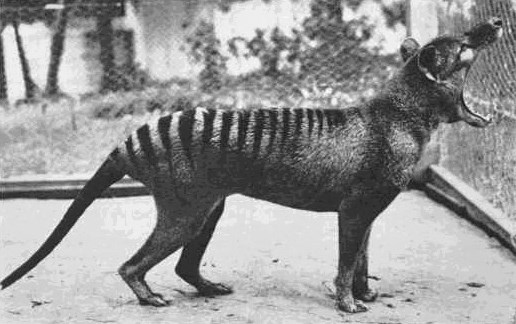
Thylacines ... have a very nasty hunting technique of BITING OFF FACES. They aren’t bloodthirsty or anything, even taking turns to feed in an orderly fashion, but their hunting technique is rather mean.

Gigantopithecus are 3m tall, 500kgs, and STILL able to climb rather well. it looks like an Orangutang trying to play Gorilla, but with only minimum sexual dimorphism in terms of size (males are still bigger) and it’s working out very well. Like orangutans, they are natural cage breakers. They also have very strong jaws and large canines. They will bite when angered, and if it wants to, it is strong enough to wreck several people in a charge.

Capybara, Mouse Deer, Tapir, Peccary, Giant Anteater, and the de-extinct trio would have outdoor enclosures, naturally.
Most of the reptiles would be in the aquatic section, but there are 4 that would be here.
Tuatara (Modified for tropical environments), the Aldabra Giant Tortoise (possibly grown to “Testudo atlas”/Megalochelys atlas sizes -- almost 7ft across and weighting 4000kg), Quinkana, and Megalania.

Why? Because Quinkana is a cool crocodilian land predator, and Komodo Dragons are basically island dwarf versions of Megalania. Quinkana is 6m long (so it’s Q. fortirostrum rather than any of the other species), and Megalania 7m long.
Once again, we have the unexpected from the de-extinct animals.
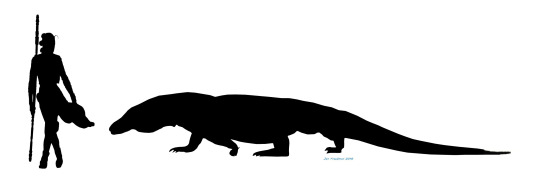
Megalania has two things that were discovered recently in its descendants. First, it is venomous. The venom lowers blood pressure in the victim. So, combined with its horrible bite, the victim will more readily bleed out. The other factor is they retain the Komodo Dragon’s ability to have virgin births. So, despite being female, they can generate MALE offspring asexually.
I think, narratively, it would be more fun for this to be the source of the breeding dinosaurs in Jurassic Park.
Despite being a crocodile, Quinkana is very active and mobile. It’s also a decent digger. So it makes a mess of the initial enclosure.

There are a few birds in the fossil house, both the subject of De-extinction efforts. The Dodo and Upland Moa. Both have some accessible DNA, and modifying birds' eggs is not too far fetched given what they've already done.
The last section of the Fossil House can be called the “Carboniferous Swamp” as it’s a re-creation (as best they can do) of that environment. Here are many amphibians, some with a proper prehistoric pedigree: Greater Siren, Midwife Toad, New Zealand Primitive Frog, Aquatic Caecilians, and Giant Chinese Salamanders. The latter of which naturally can be up to 6ft long. JP scientists ensure that they get big with modifications, and have gotten a few 2m monsters loafing around the “Fossil Zoo.” Basically, as many “Living Fossils” as they can cram together.
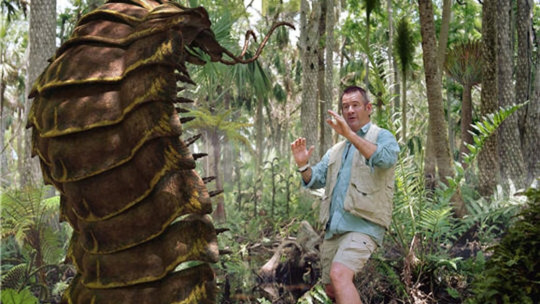
But the real prize here is the insects. There are a few ‘standard’ ancient insects, and some velvet worms on display. But the prize is the 4 ‘recreated’ insects. InGen’s versions of Pulmonoscorpius, Meganeura, Arthropleura, and Manoblatta. A 70cm scorpion, a Griffon-fly with a 65cm wingspread that was also 70cm long, a millipede 1m long, a 40cm cockroach, and a 1m Centipede.
Yes, a 1m Centipede. Narratively, we WANT things to go south, and well, there’s an episode of Lost Tapes which really has fun with giant Centipedes.

And once again, the Chaos Effect rears its head. Of course, they are breeding despite their best efforts. But it’s more than that.
The Pulmonoscorpius they have is derived from an emperor scorpion. This means it can burrow better than they expected, and while the venom of the base animal is not dangerous, the dosage in their Pulmonoscorpius makes it so. Paralyzing adults. In the weak or young, it can lead to coma and death. Also, it’s more aggressive than the base species.
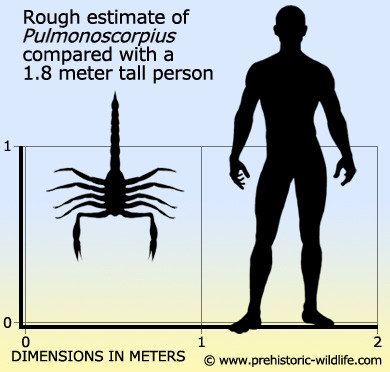
The Griffonfly is the most active among them and can use its wingbeats to breathe more effectively. It spends most of its time growing as a nymph, and a short portion of its life as a flying adult. To hold it, you need a falconer’s glove.

The Millipede Arthropleura is armored as heck. Far more than they expected. And it gnaws like a rodent.
The Centipede Arthropleura is a monster. It’s fearless and willing to attack people, with venom enough to greatly harm a person (killing the small and weak). Multiple bites can be fatal. They also act as carrion eaters.
And the roach? It’s an omnivorous scavenger. If hungry enough, they will gnaw on people who are sleeping near them.
The Aquarium (and Other Water-Ways)
There’s a lot of aquatic “Prehistoric” animals to draw on without genetic engineering. Considered “Fluff” by the park, they nevertheless flesh things out.
There are native fish in the waterways, mostly killifish. Ingen brings in (and modifies) Bichir, Paddlefish, Sturgeon, Lungfish (South American and Queensland), Gar (Tropical and Alligator Gar), Coelocanth, Bowfin, Arapaima, and Silver Arowana. Several of these are prized gamefish, so of course, Jurassic Park has a pond to fish for them.

The aquarium also includes Amphibians: Greater Siren, Midwife Toads, New Zealong Primitive Frogs, Purple Frog, Hula Painted Frog, and another Giant Salamander.
Aquatic reptiles are where things get more interesting. There’s are tanks for sea turtles (Olive Ridley’s Sea Turtle), Pig Nosed Turtles, an Alligator Snapping Turtle, and (of course) American Alligators.
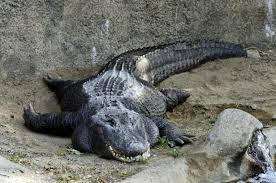
Now we get to the cloned animals. First, the aquatic crocodile Metriorhynchus. Also, Titanoboa (They call it Gigantophis, but it’s Titanboa). Nothosaurus, Ichthyosaurus, Plesiosaurus, and Mosasaurus round out the menagerie.
So, how do they go wrong?
Well, half of these animals give live birth, so the standard cloning technique didn’t work until they made an artificial womb. Titanoboa is misidentified and almost fully aquatic.
Metriorhynchus will ‘nibble’ larger prey. Bite off chunks of something swimming by, darting in and out. They may or may not kill people this way, but it will maim and ‘disarm’ them.

Nothosaurus have very dextrous hands, making the seal-reptiles natural cage breakers. They are also great climbers, so they speculate that the animals lived in rocky environments.
Ichthyosaurs look like dolphins, but they are not. More skittish than dangerous.
They thought Plesiosaurus was able to haul itself onto land, but it is not.

Mosasaurus... It is a mosasaur. A second roar of jaws to manipulate prey it captures is pretty badass enough. And it can swallow a person whole with little effort.
Among the dinosaurs, we have the Great Auk, the Original Penguin. Another recently extinct bird. Another bird in the Aquarium is the Common Loon, but by comparison, it is a minor addition.

The Great Auk is an exceedingly brave bird. It will not run readily, preferring to peck and bite when confronted. Why it’s so brave is not evident, but it is, and won’t take ‘no’ lying down.
The jewel of the dinosaurs in the aquarium is the Halszkaraptor-- the diving duck raptor. Because, really, how could I not? This one is weird enough on its own.
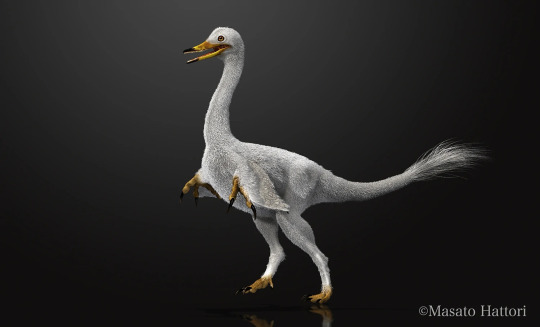
The Aviary
When I first put this together, I made an effort to keep the Pterosaurs small. I’m going to make some exceptions to that for Jurassic Park fun.
Modern Birds brought into parts of the aviary (because it has parts) are Tinamous, Seriema, California Condor, Magpie Goose, Mousebirds, Bearded Reedling, Broad-Billed Spaayoa, and Hoatzin.

Cloned birds include the Carolina Parakeet and Passenger Pigeon. These two have large open enclosures because they require a LOT of animals in their group to be comfortable. So already, there are over a hundred of each of these animals.
Avian Dinosaurs in the park include Archaeopteryx, Microraptor (which they call Tetraptertyx),, and Ambopteryx.
Archeopteryx is a glider capable of downward flaps, but no upstrokes. A generalist with the coloration and overall habits of a solitary crow.
Microraptor is a better flying and climber than Archeopteryx with its four wings and wider grip, it doesn’t seem to mind people and will use them as perches -- which can be dangerous when their claws go in the wrong place.

Ambopteryx is the largest winged Scansauropteryx. An omnivore, this bat-winged beasty is just over a foot long and vomits caustic, foul-smelling stomach contents onto attackers when it is angry. So, really, it’s a “Dragon.”
Ceredactylus was the main Pterosaur in the Aviary in the book, and I’ll keep them around too. Complete with territorial nature.
Other Pterosaurs in the Aviary include Pteranodon, Quetzalcoatlus, Sordes, Anurognathus, and Dimorphodon.
Unlike the films, this remembers that Pterosaurs use their heads for grasping prey and have no eagle talons.
Pteranodon is more gregarious, an albatross scaled up.

Quetzalcoatlus is just... well, your basic Giant Azdarhkid pterosaur. It will totally spear a person and eat them. But it spends a lot of the time on the ground, so it keeps the enclosure size small ... for a Giraffe sized animal. And yes, it will eat people if it can.
Sordes is an eater of insects and amphibians. When disturbed, they will swarm around an attacker, pecking and biting to drive them off. This can lead to some unfortunate accidents.
Anurognathus is basically a pterosaur owl and insect eater. They have the same unnerving effect as owls. Their defensive cries and glowing red eyes are terror inducing among humans, easily generating panic.
Dimorphodon gallops along the ground most of the time, flying only for short distances. Insects and small animals make up the bulk of their diet. If it’s small and fast-moving, they will try and take a bite. That includes fingers. Or whole hands.
The Park
Now we come to the dinosaurs. There are 3 main groups of them in the park: Minifauna, Fauna, and Megafauna. The Difference comes down to weight. Megafauna is reserved for animals over a ton. Fauna is for animals above 20kg (or 50lbs). Minifauna is for animals below 20kg on average.
The park comes with 21 examples of Megafauna, 10 examples of Fauna, and 10 examples of Minifauna.
In the Megafauna, many of them are prone to being ... chaotic.
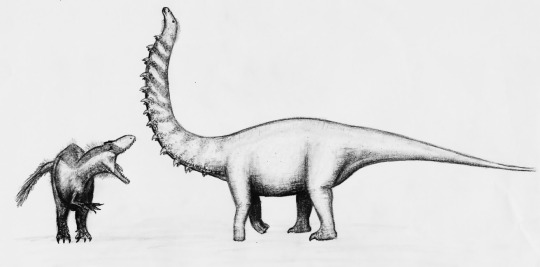
Apatosaurs are the second biggest animal in the park by weight (15 tonnes). Their necks are lined with spines they use for defense and in contests with each other. They also have a line of raised spines along their backs, which become quite wicked at the tip of their tail. Lashes with their tail, done to other herd members in dominance points, or against what annoys them, can be very dangerous. But not as dangerous as when they rear up and try to smash things with their feet or neck. It’s also a low feeder/grazer, vacuuming up food as it moves its head side to side.
Camarasaurus (C. lentus) are the heaviest animals in the park (20 tonnes), and are mid-range browsers. They are docile, but their large nasal cavity proves very enticing to Avian Flu, which it acts as a carrier for, but doesn’t really suffer from.
Spinosaurus is a big land pelican/Waddling Penguin/Crocodile thing. Big claws and jaws are nasty enough on their own with its semi-aquatic nature making it versatile, it still is goofier than it has any right to be. Which masks its danger.
Saltosaurus is a sauropod hippo with armored scutes along its back. That’s pretty darn weird enough. It’s as heavy as an elephant, and a browser as well, but not to the height of some other animals...
Tyrannosaurus hunts in packs like wolves, so they had to make a group of them as “Sisters” to prevent self-destructive behavior. So there are 4 “Sisters” that the park knows of. With all we know about T. rex, there’s not much more to ‘enhance’ it other than letting it be as smart as a modern alligator, or house cat. Yes, they are comparable. Eagle-Eyed, nose better than a bloodhound, and with powerful jaws, it is an apex predator for a reason.
Triceratops has small quills along its torso and back like a porcupine to defend itself in addition to armor plaiting. They prefer to travel in small groups and fights for dominance can occur if the group gets larger than 5 or 10 individuals.
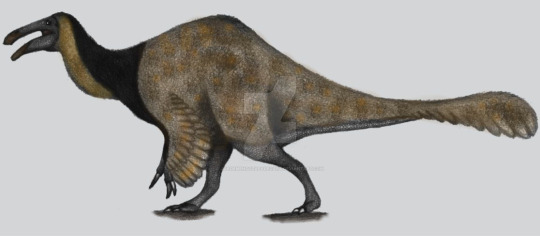
Deinocheirus is r one of those dinosaurs “This is too weird for the 80s to handle” we now know of. When riled, its arms are very dangerous weapons. And it will bite, even if only to toss away smaller attackers. Eating fish and plants, this animal has an impressive bluff display, and confidence to back it up.
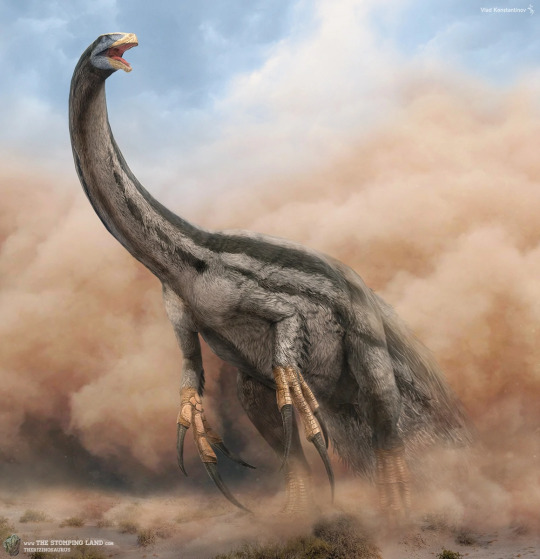
Theirizinosaurus is very weird, and worse, has the personality of a goose or swan. Very confident, will rush down what it thinks are threats, and those claws make it very dangerous.
Omeisaurus uses its clubbed tail to establish a pecking order (or “smashing order”) in the herd.
Euhelopus is one of the few true browsing sauropods, really resembling a Giraffe in posture or a small Brachiosaurus/Giraffatita. Like a Giraffe, it can kick with a LOT of force. Enough to decapitate a man from brute force alone. It’s the smallest of the long-neck Brachiosaurus, which is why it was targeted for cloning.
Ankylosaurus is a goat. It eats damn near anything. Primarily eating leaves, it also adores fruit, and will go after large insects when it can. Or swarms of them it just licks up after breaking open a nest. They are proficient diggers as well, they like to sleep in burrows they build. It’s also very well camouflaged, so you can trip over it and it will likely take a swipe at you for your mistake.

Edmontosaurus may be considered a ‘simple’ dinosaur from the bones, but that doesn’t tell the whole story, not by a longshot. See that picture? That’s an Edmontosaur!
Stegosaurus is an extremely stupid ninja. It moves quietly for its size, can wiggle and turn its plates red when angry as a distraction, and fold its whole body into a U shape to better strike enemies with its thagomizer. And it is not afraid of groin shots.
Styracosaurus is all about intimidation. When confronted, it will mock charge, holler, stamp, and make a fuss. But if you stand up to it, it will back off, or even run away.
Amargasaurus uses its neck spines defensively while grazing. When threatened, they roll their heads under their chests, sticking out their spikes, and charge. They do this with minimal provocation. They also lash their tails around wickedly.
Parasaurolophus is LOUD. Constant maintenance is needed on the paddock as they can rattle apart their paddock locks if they are not checked regularly. It also gets the attention of certain predators regularly. Insulation has so far proved ineffective.

Gigantoraptor is pretty damn weird all on its own. An omnivorous oviraptorosaur over 12ft tall at the hip, feathered and fearsome. It uses its feathery arms (as well as a displaying throat pouch to communicate with members of its species.
Allosaurus, the lion of the Jurassic. They behave similarly to crocodiles, but more actively. Which means they hunt semi-cooperatively. Because of their primarily slashing jaw setup and strong necks, they prefer to bleed large items to death rather than quickly kill them. They can still swallow a man whole (as long as they aren’t too big).
Plateosaurus is a large, primitive planteater. It walks on its hind legs, despite its size and descendants. When threatened, it rears up and tries to claw attackers who get to close like an irate Ant Eater. And those claws are very mean. They rake trees with their claws as a demonstration of power in the herd.
Borealpelta digs ruts for themselves to sleep in at night. This means only their armor bits show up. They usually use the same one when they can, but it still damages enclosures.

Carnotaurus is a Cheetahs. Extremely long-legged runners at high speed, and at long distance. They can also swallow a man whole by stretching their jaws out. Also, its tiny arms are used for flappy dance displays.
Now we come to the Fauna, which are small enough to get inside buildings and still be a visible threat to humans on occasion.
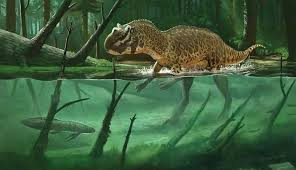
Ceratosaurus is basically a bipedal crocodile, scutes and all. The nasal horn is flat and largely for display. They prefer swampy environments and eating aquatic animals. The thick hides of these animals make darting almost impossible, and mildly resistant to small arms fire.
Pachycephalosaurus have dynamic skulls, the younger ones being spikier than the adults. And they will butt EVERYTHING that annoys them even slightly. Worse still, they are omnivores. They decrease the amount of meat in their diet as they age, but they won’t turn it down.
Dilophosaurus has the frill and venom of the novel/movies, but the frill is made of feathers rather than skin and is lost in adults, which can be up to 3m/10ft tall.

“Velociraptor”, or really, Dakotaraptor, is as smart as a crow, which means minor tool use. Juveniles can fly short distances to escape an attack. They are less like wolves and more like lions in how they hunt, climbing in trees to assist in their ambushes. Think of them as ground-eagle-panthers with crow intelligence.
Protoceratops make burrows to live in. They sleep for short periods throughout the day and night, at seemingly random intervals.
Struthiomimus’ fully developed wings are colorful, large, and help it maneuver at speeds up to 50mph (80kph). They also help it intimidate others -- their claws also packing a bit of a punch. Primarily herbivorous, they are also very vocal animals. Almost obnoxiously so.
Dryosaurus is the dinosaur equivalent of a deer or large gazelle, living in small groups in forested areas. Because of this, and an extremely skittish nature, they are hard to spot in their enclosures. Sure, they are ON the tour, but the runaway when the cars come by. It makes care for them difficult as well.
“Troodon” is really Stenonychosaurus. Omnivorous, the focus on rodents and other small animals. They also feed on more fruit, seeds, nuts, and other high energy plants more regularly than InGen thought. They are the best cage breakers in the park, being the smartest animals there (yes, smarter than the raptors). They are also guide-animals. They will guide larger predators, like tyrannosaurs to food sources they can’t access, but that the other animal can. Similar to Crows and Wolves.

“Oviraptor”, really Anzu, is a large oviraptorid. Herbivorous with occasional meanderings into carnivory, it’s main gimmick is its voice. It’s a Lyrebird. It can vocally mimic anything its herd before and incorporate it into display songs. It can also use this to manipulate other dinosaurs, be it attract small animals to eat, bring ‘help’ for itself, or scare away potential threats. So, imagine a scene. A group of humans is hunting for other survivors, they hear someone crying “Help! Help!” and occasionally screaming. They rush to aid and find this tall animal here. Their guard lowered in confusion as another predator sneaks up behind them and takes them down.
“Parkosaurus” is actually Oryctodromeus. A burrower like Protoceratops, they are more communal in their nesting. It’s rather unsettling to see animals as big as a medium-sized dog pop-up out of the ground like prairie dogs.
Microfaunae are Coyote or smaller animals that can still be dangerous, but not so often or as directly.
Coelophysis is the “Emu” of the park. They are inquisitive, but also not very bright. They are also opportunistic. Which can be hilarious, but also dangerous, because you are made of meat. And they see no qualms with biting someone and running away again and again. In groups.
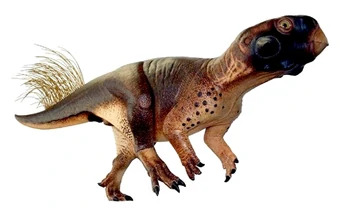
Psittacosaurus rattles its tail feathers as a means of simple communication. They also bite with a lot of force when agitated, enough to take off a hand.
Dromaeosaurus is a small raptor (or rather, typical, medium-sized one), but one more heavily built to take down prey larger than itself. This one will hook onto a person and bite away, ripping out chunks. Given they are about the size of a turkey, several of them can do that to a person.
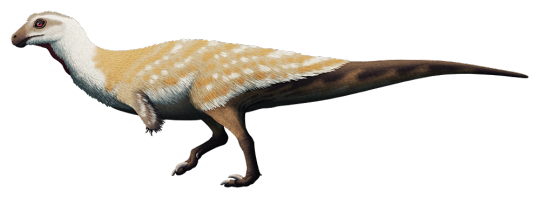
Vespersaurus is an opportunistic omnivorous desert dweller that runs along sand primarily, using its single grounded toe to get better traction and movement. Its kick has TWO large raptor-like claws on it, making it extra nasty.

Limusaurus is another Noasaurid, a strange group of dinosaurs related to Ceratosaurus. This one changes its diet as it ages. As hatchlings and juveniles are omnivorous, eating plants, insects, and small animals. As they become adults, they switch to an entirely herbivorous lifestyle. This confused the hell out of InGen first time through.
Nanosaurus (a.k.a. Othnelia/Othneliasaurus) is a tiny ornithopod that fills in the same role as a Thompson’s Gazelle. Small, grazing, and skittish. They like being in large herds for protection.
Panphagia is an omnivorous ancient sauropod relative and the oldest species of dinosaur in Jurassic Park. A consummate opportunist, its hands make it a pretty decent cage breaker. And it really will eat anything, almost as much as the Ankylosaurs or goats, but more carnivorous.
Procompsognathus is a chicken-sized carnivore that eats small animals as well as scavenges for food. It is also venomous, operating in groups to take down injured animals larger than itself.

Compsognathus, by contrast, is a housecat in terms of personality. An expert killer of small things, but can easily cozy up to humans. Considered “Petting Zoo” material, if not for their teeth and claws.

Shuvuuia is one of those animals that scientists even today don’t really know how it works and is also one of the smallest nonavian dinosaurs. It uses its claws to break open rotting wood and picks off insects very quickly. Because it eats a lot of poisonous insects and acid-filled ants. And it converts that into pure stink. Yeah, it’s an anteater-skunk dinosaur.
Final Thoughts
I could probably have shaved things down to 10-15 of the movies/books, but I wanted to fill things out not just for variety, but for a proper park.
I’ll probably revisit this for a later post...
8 notes
·
View notes